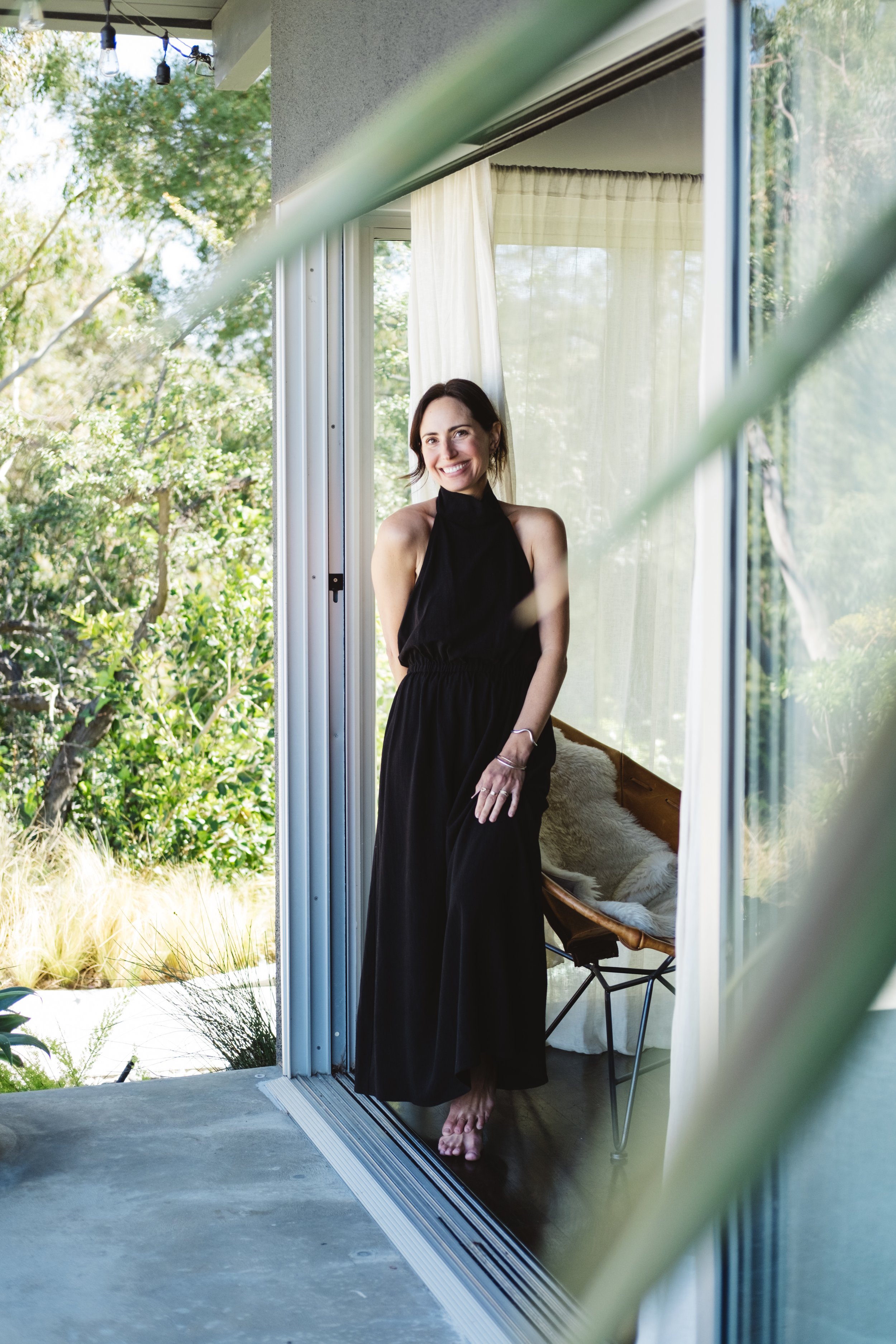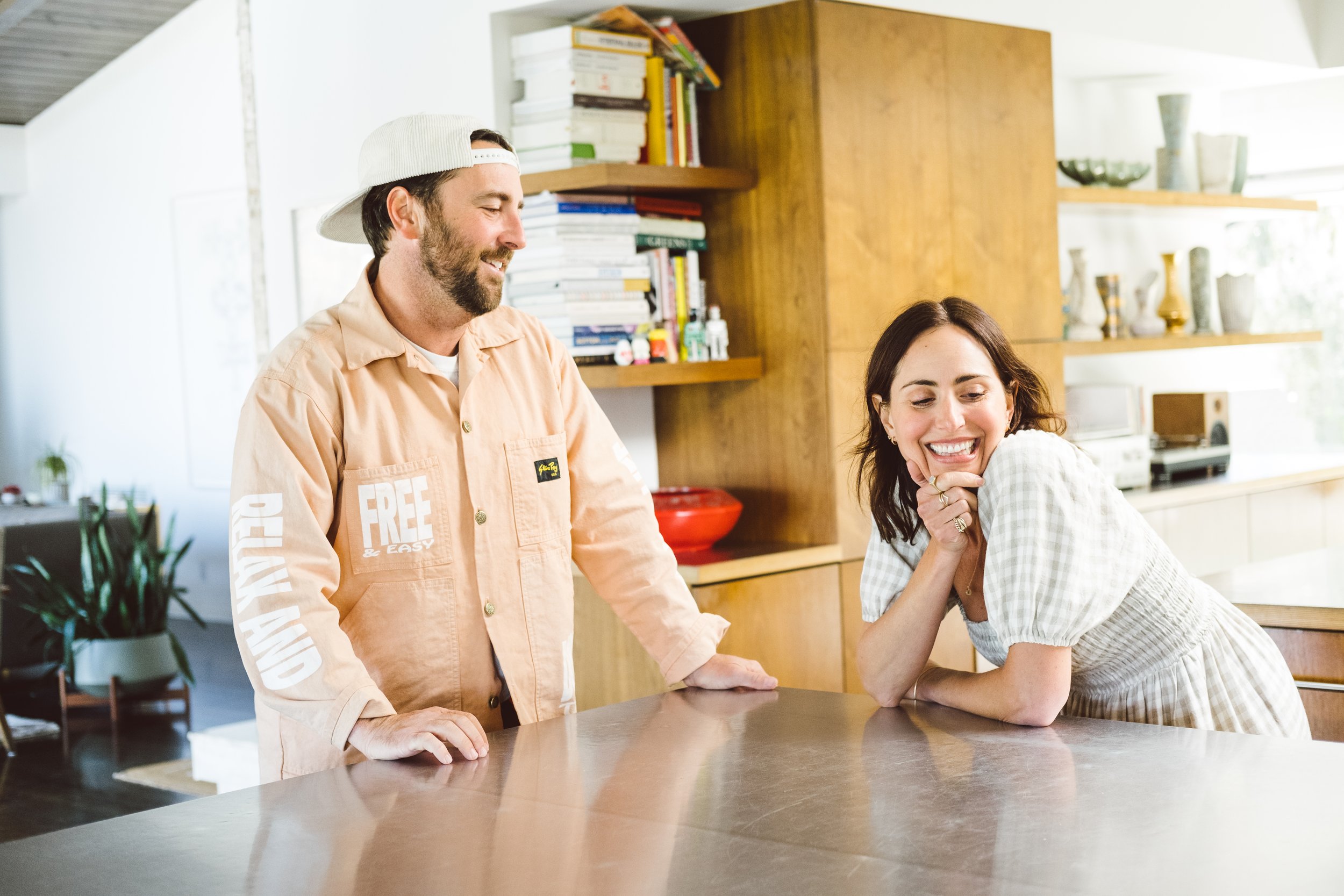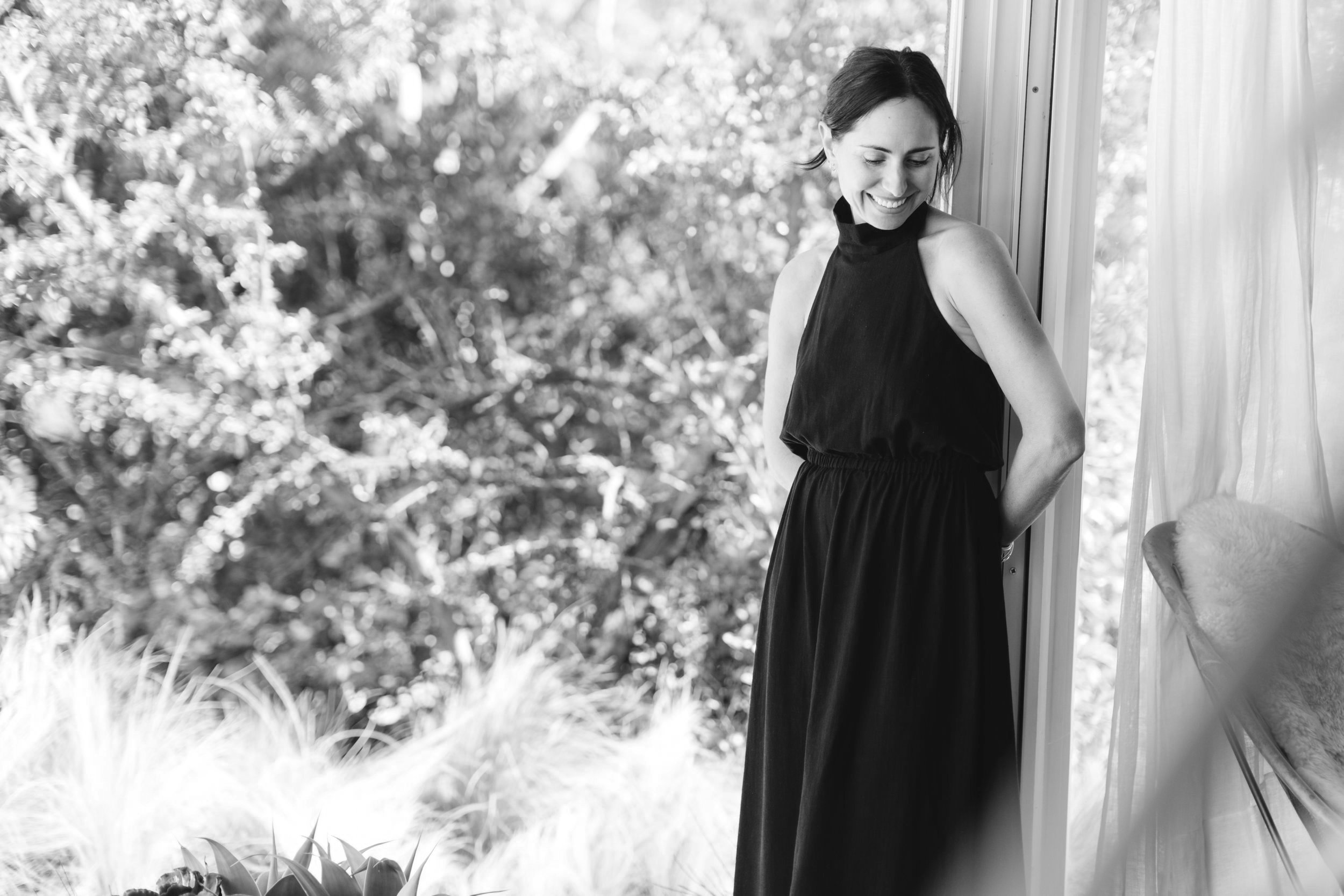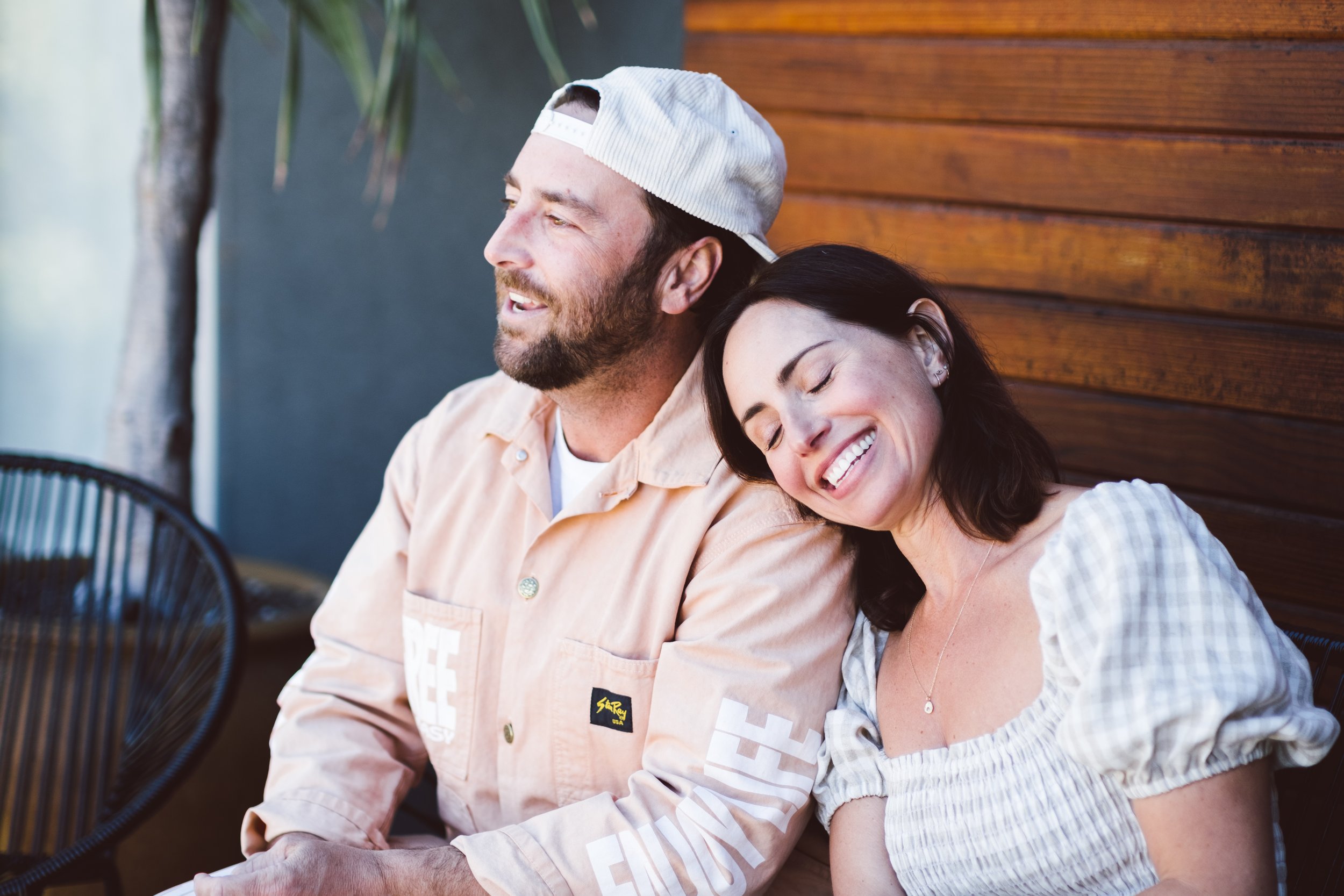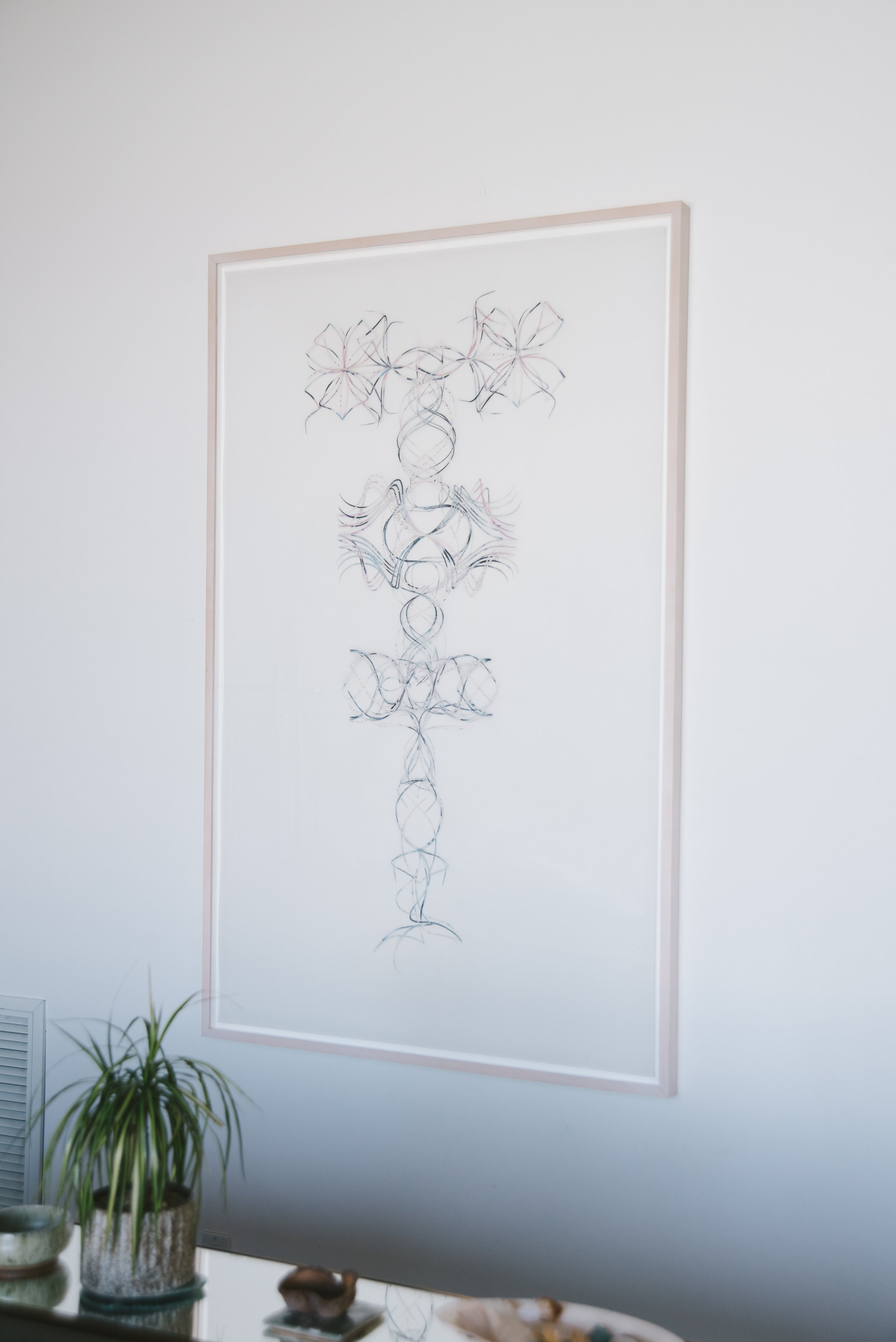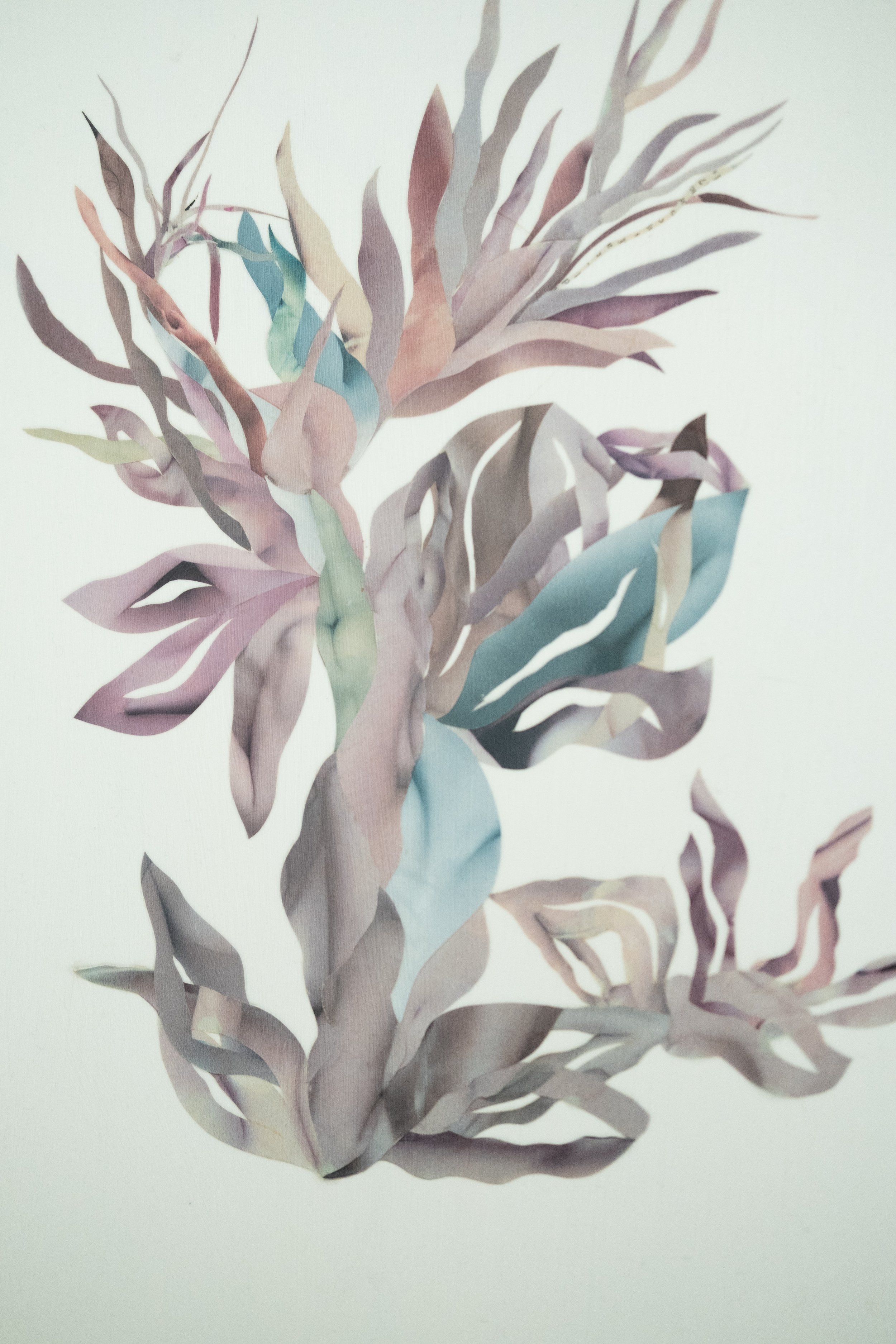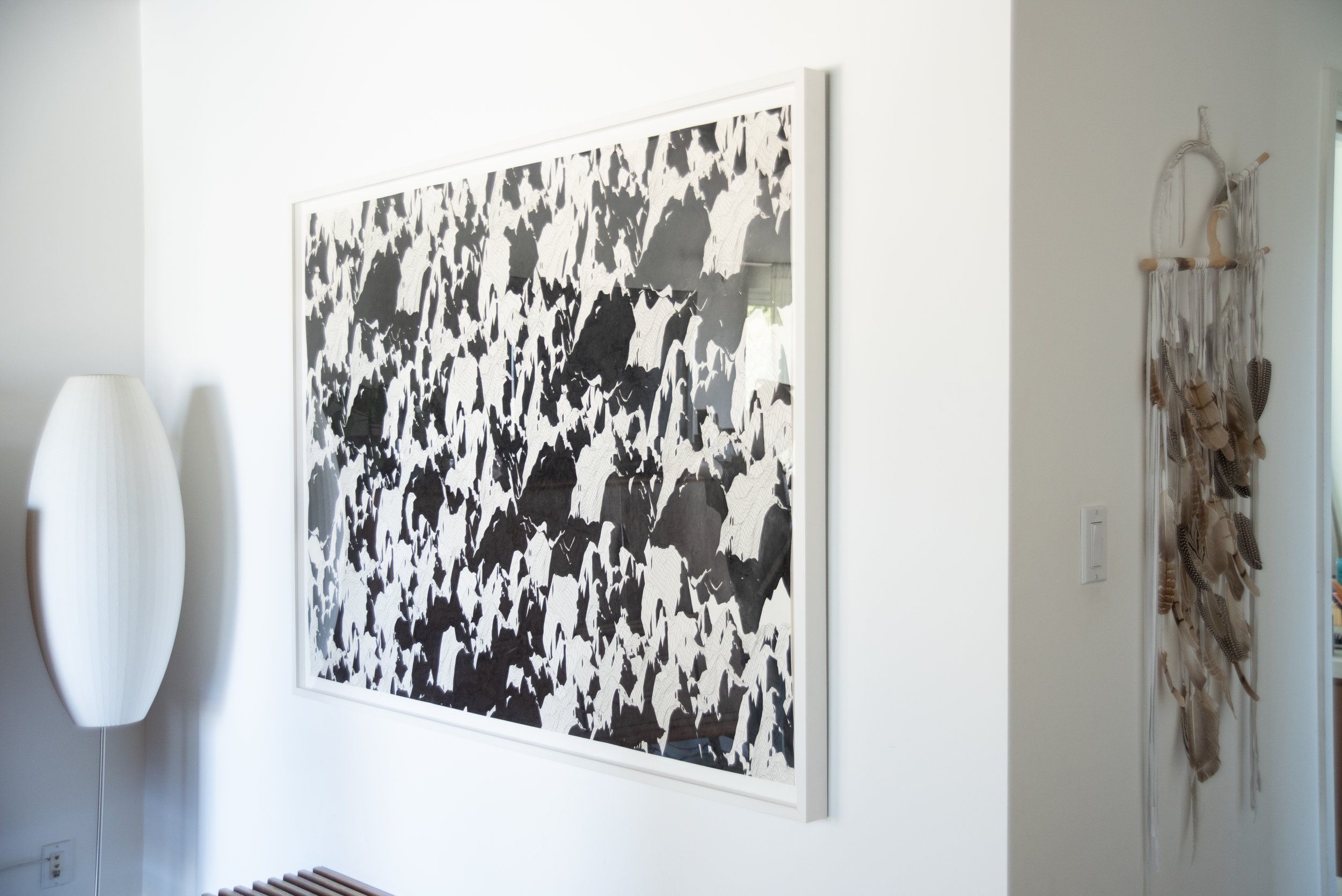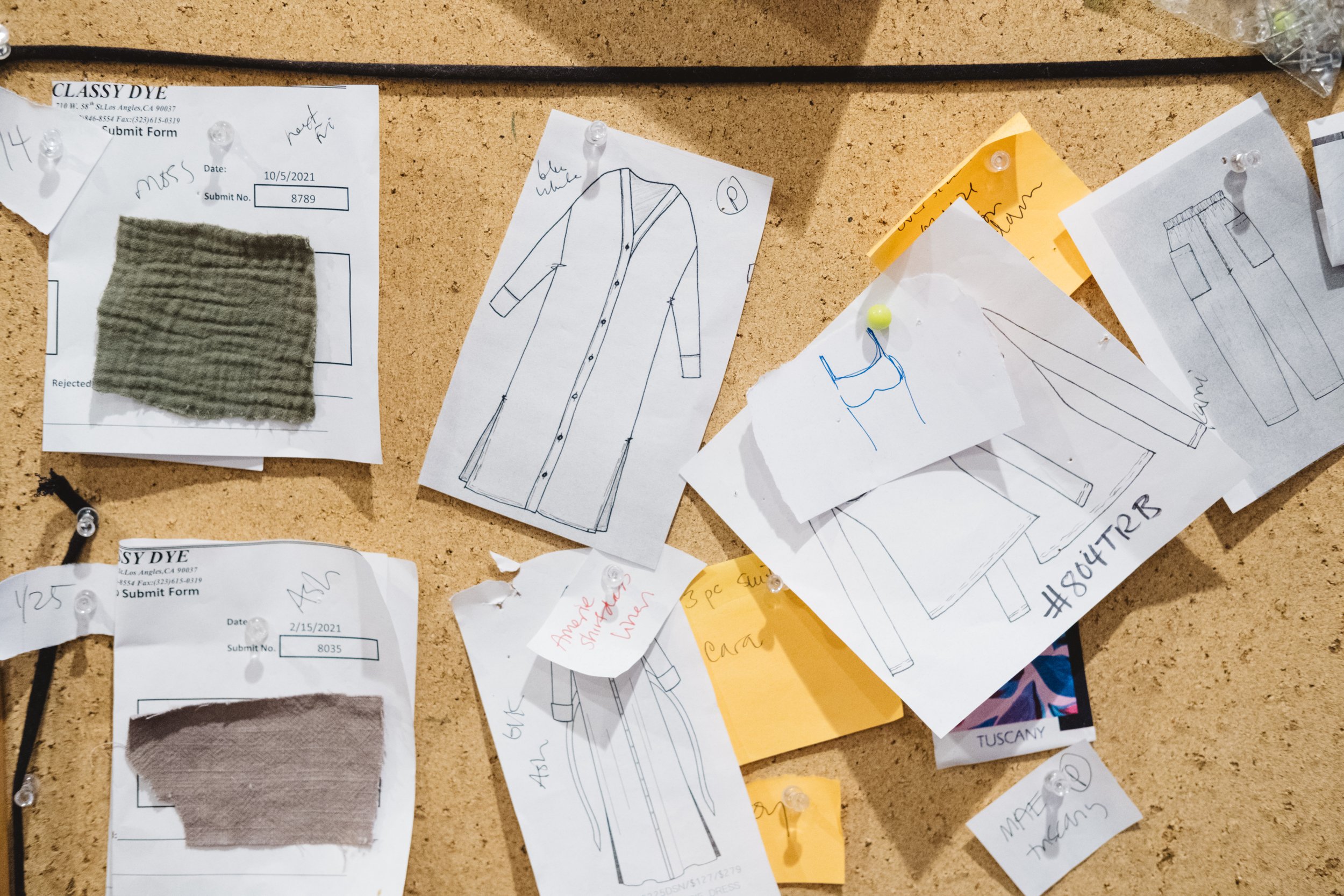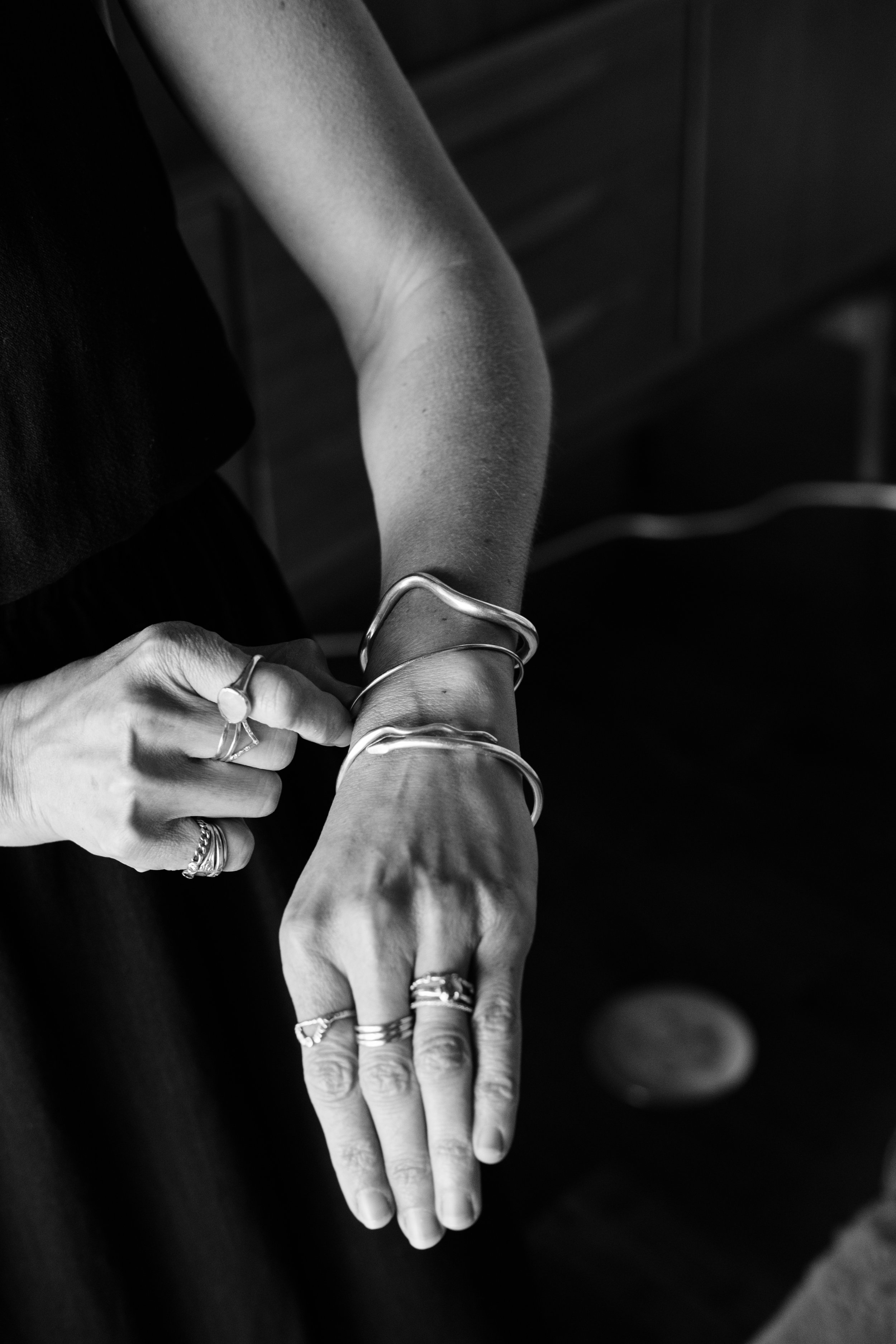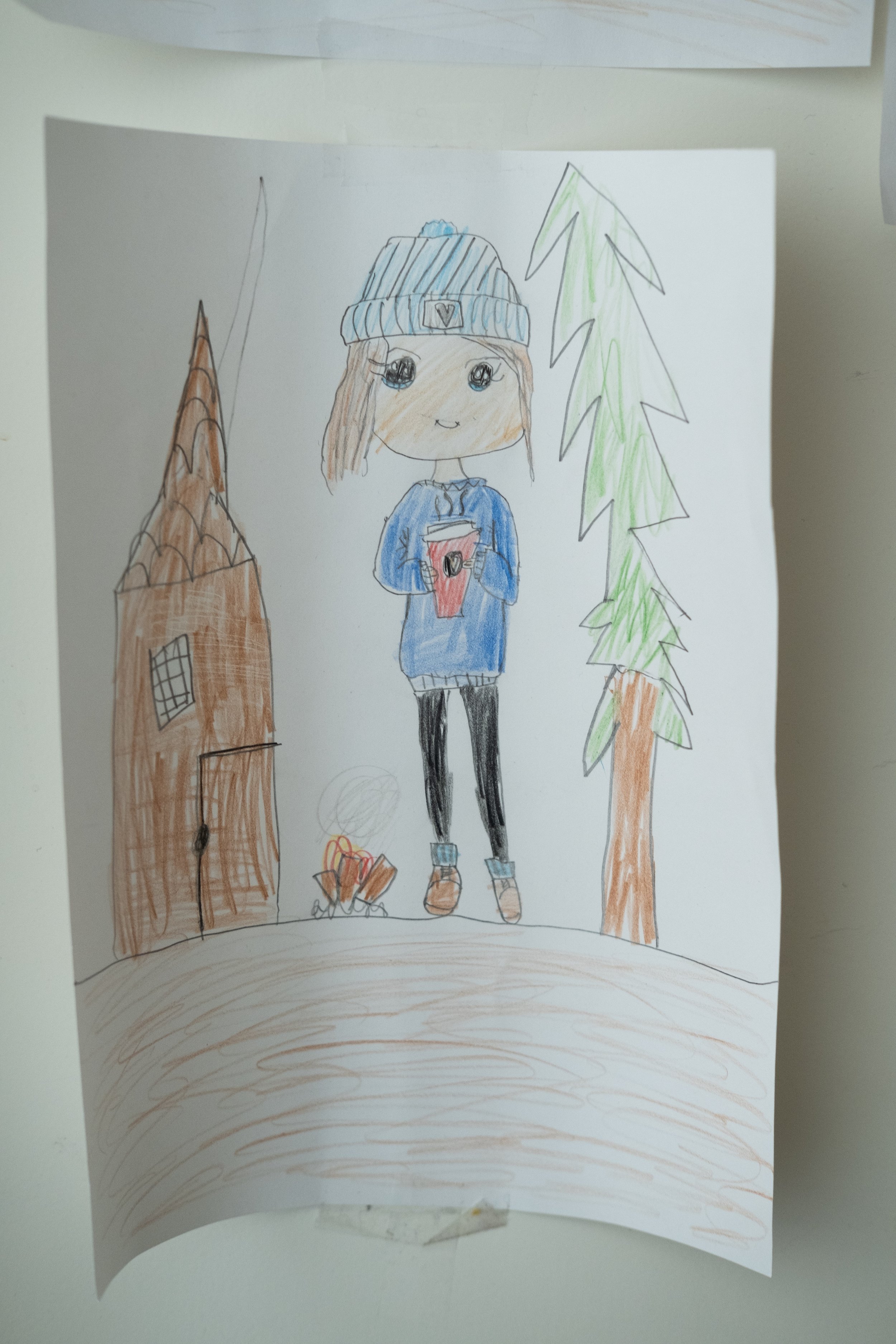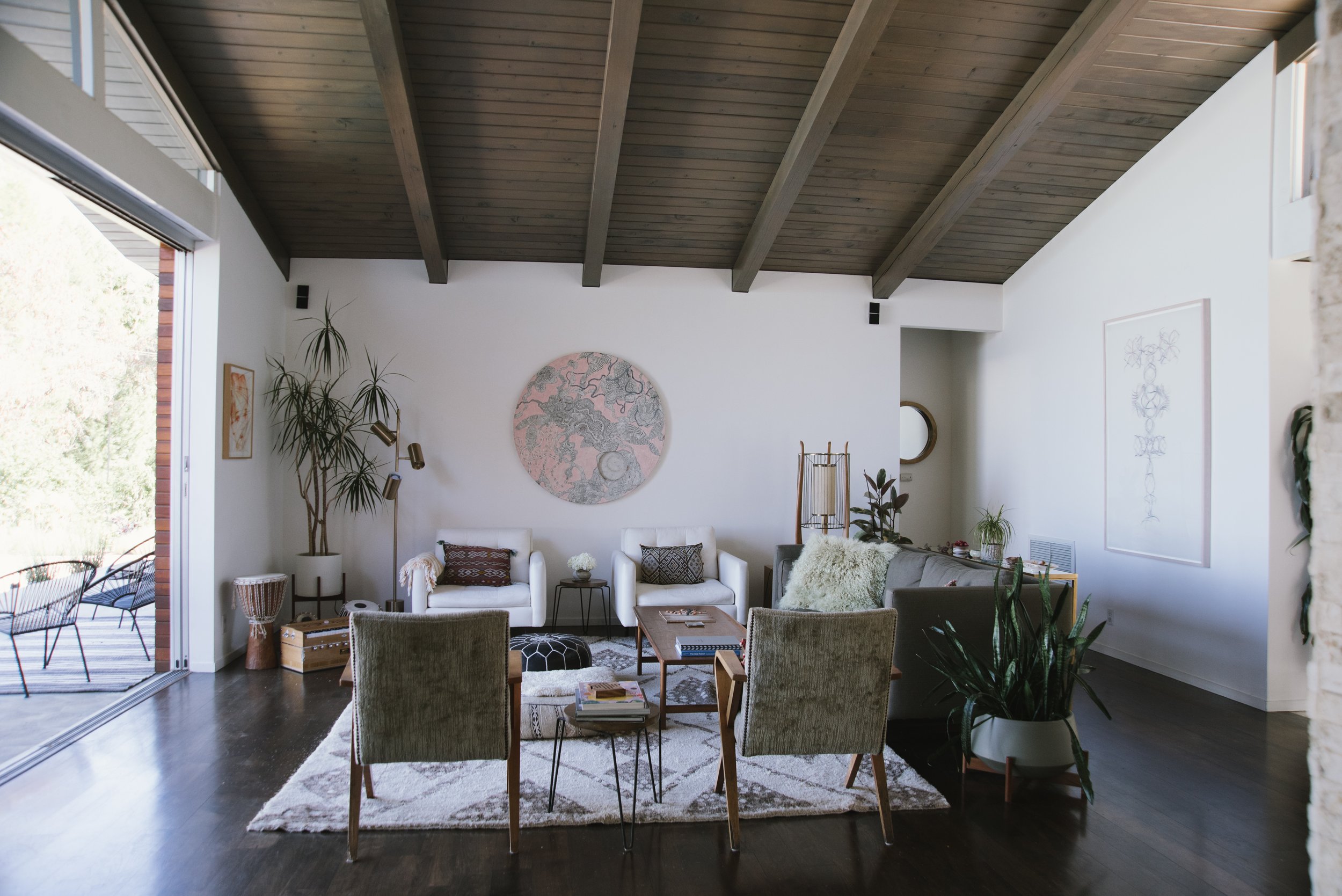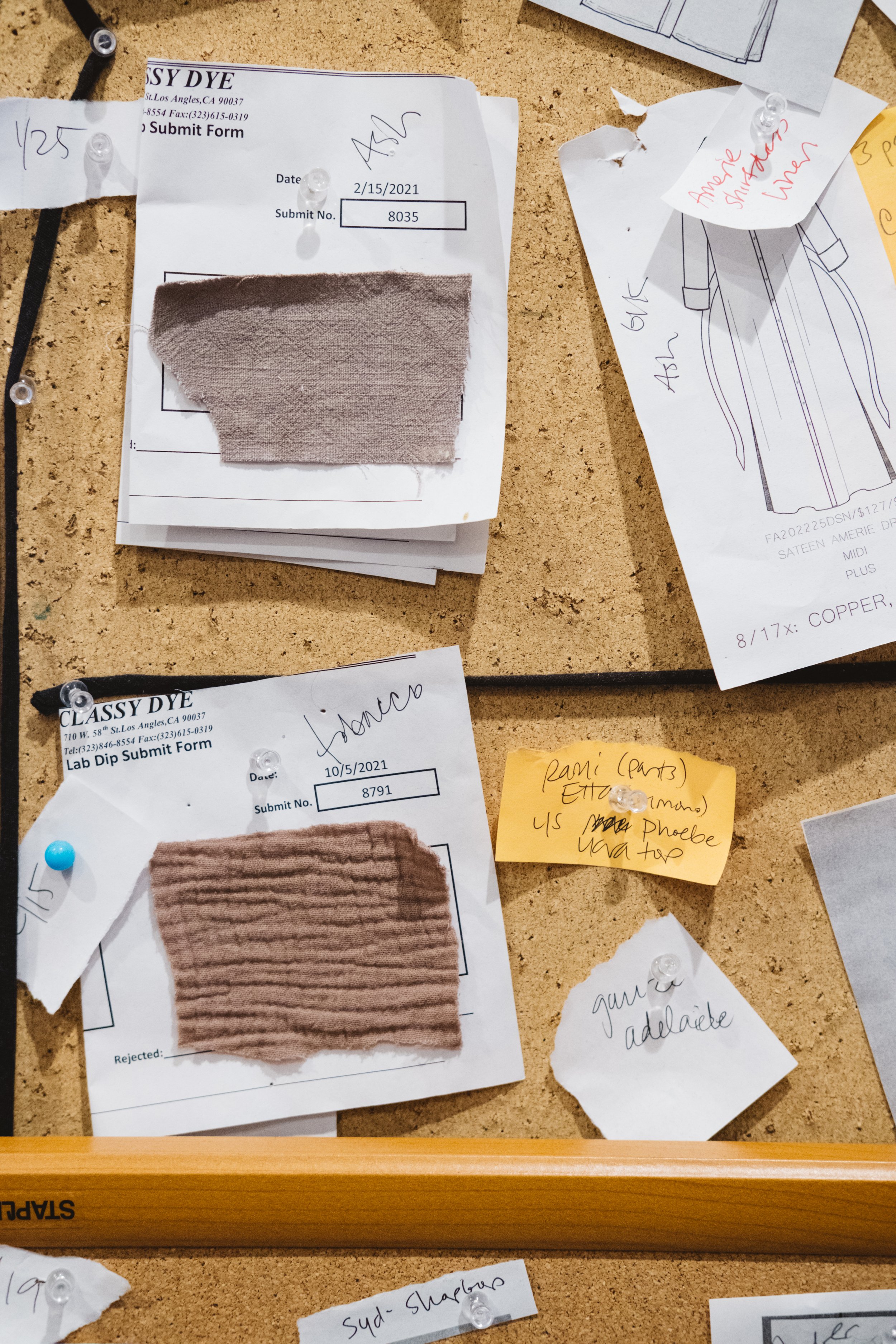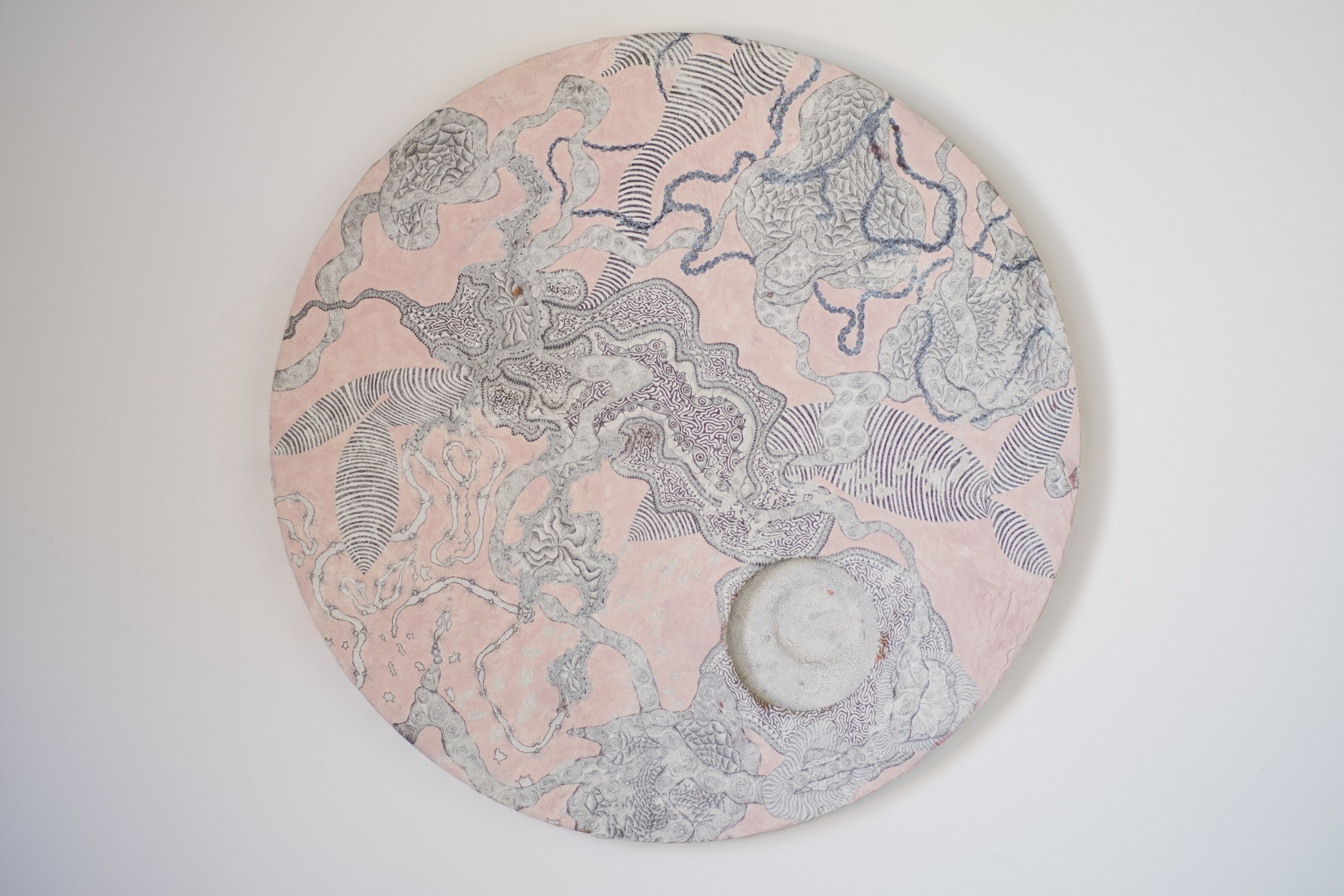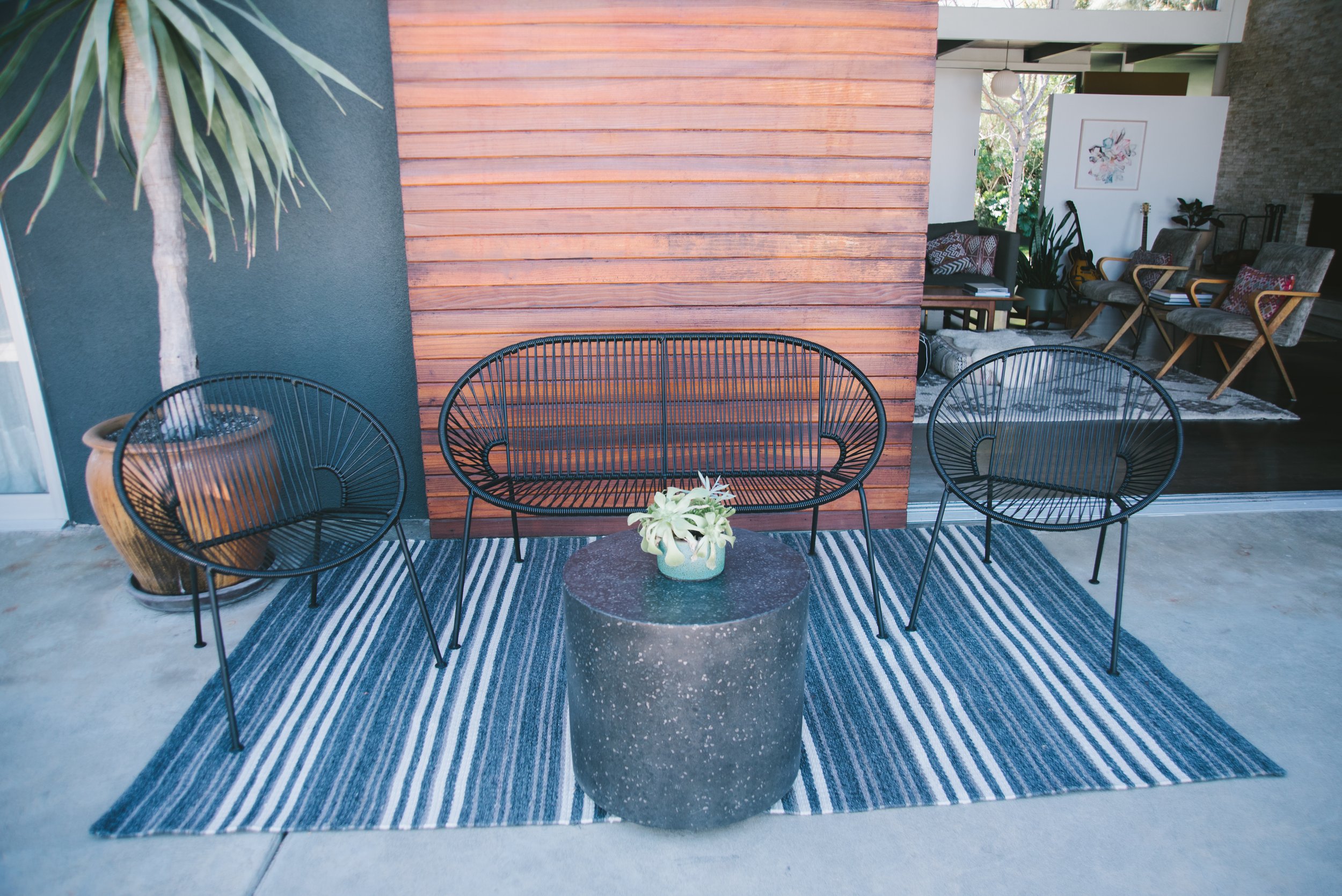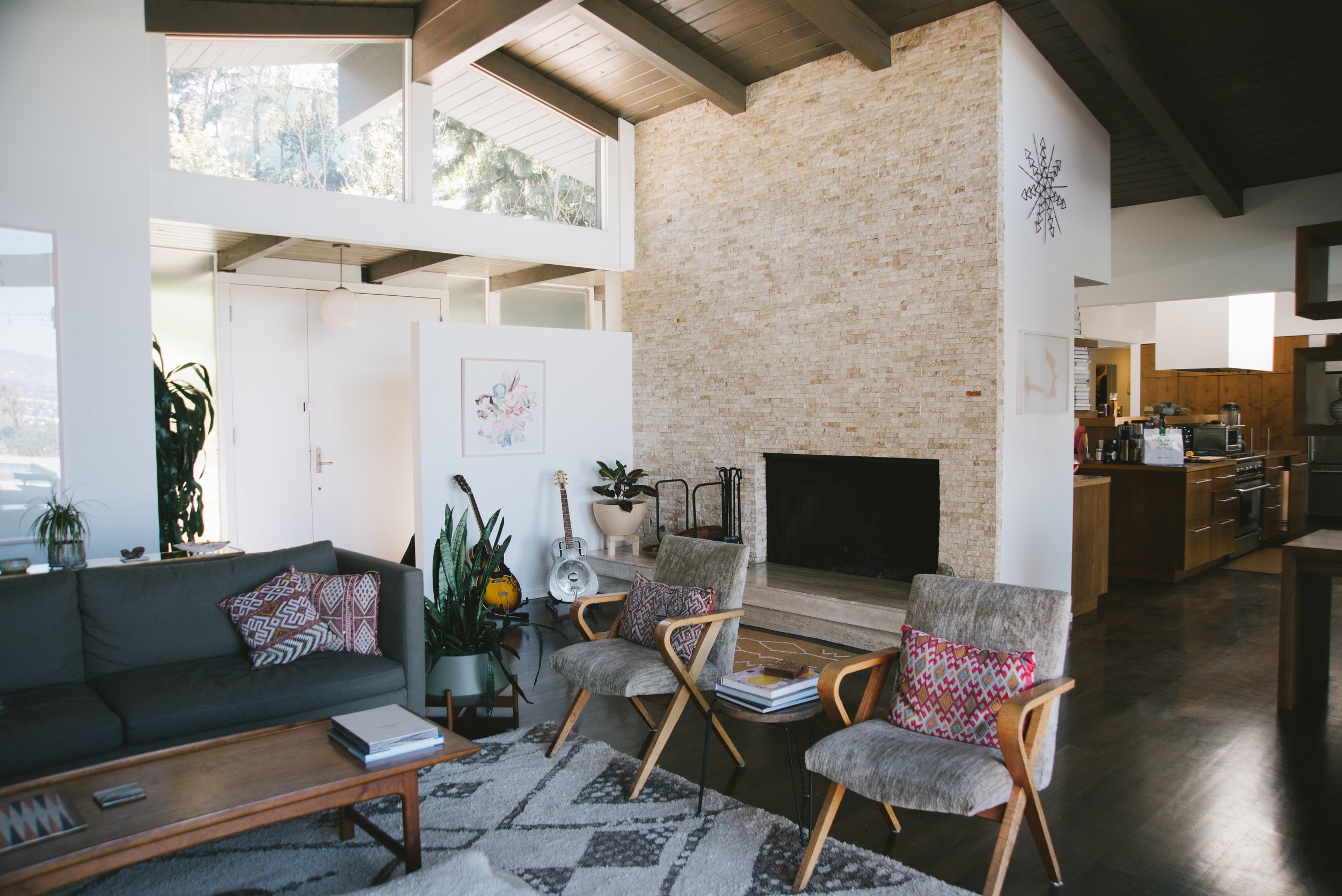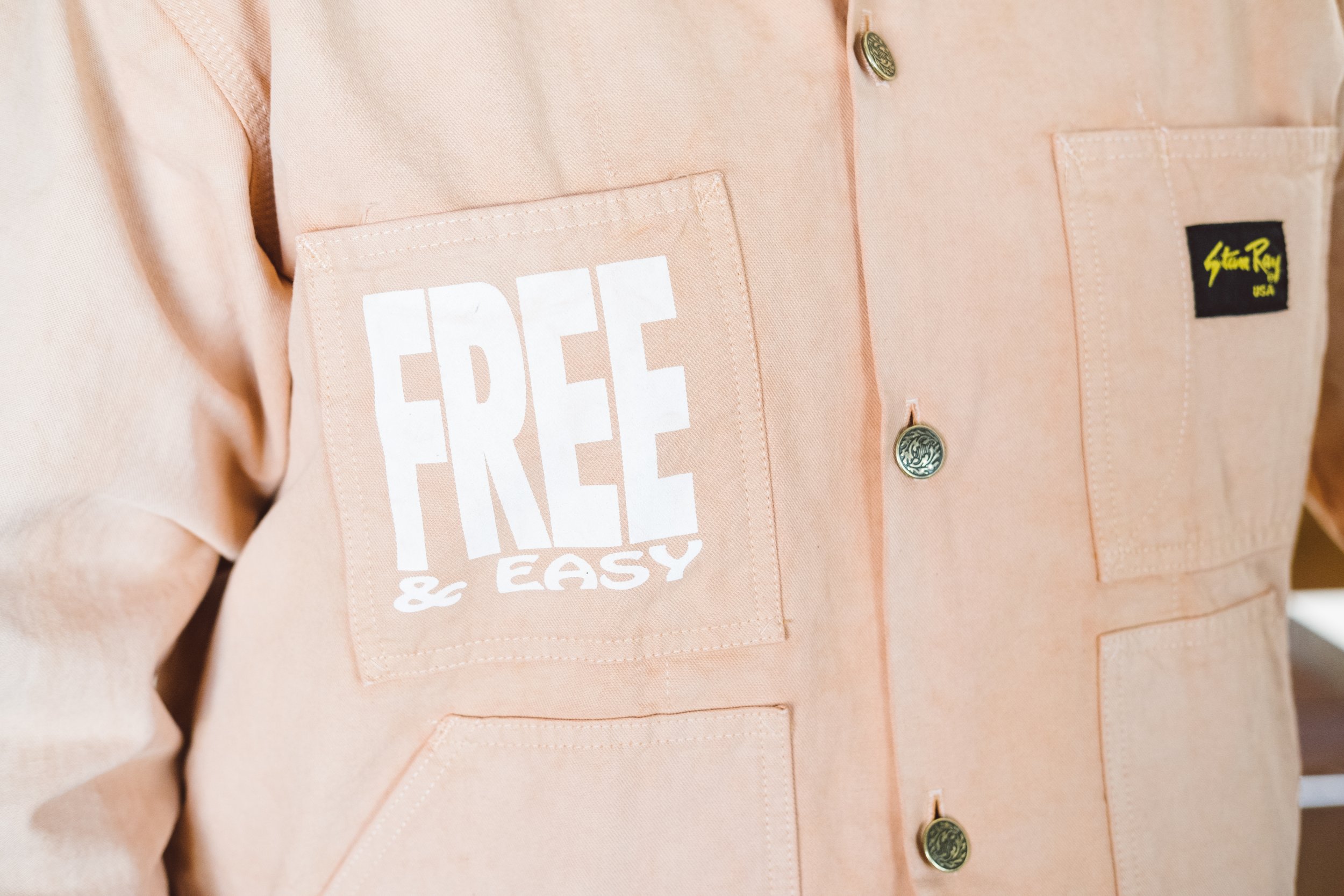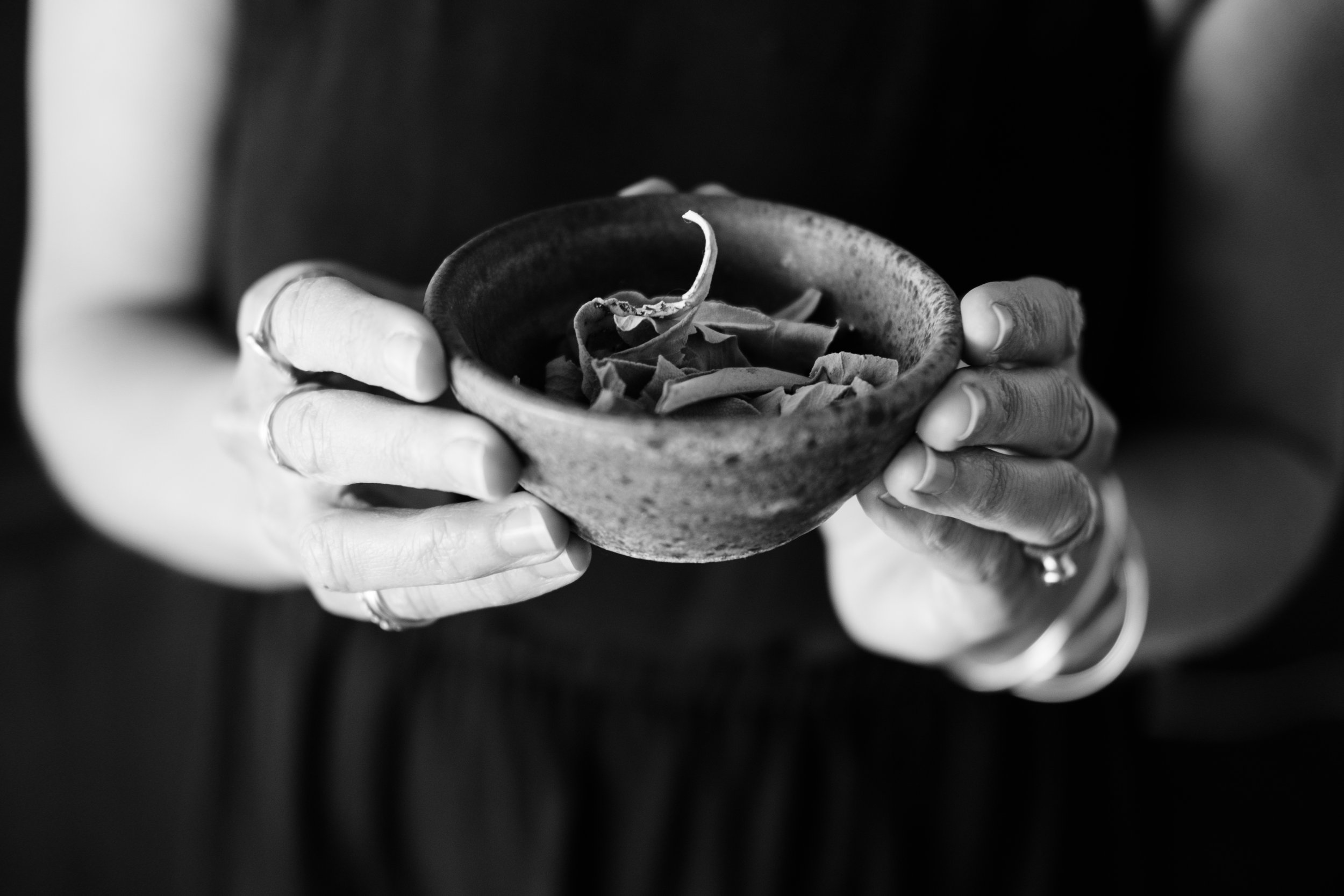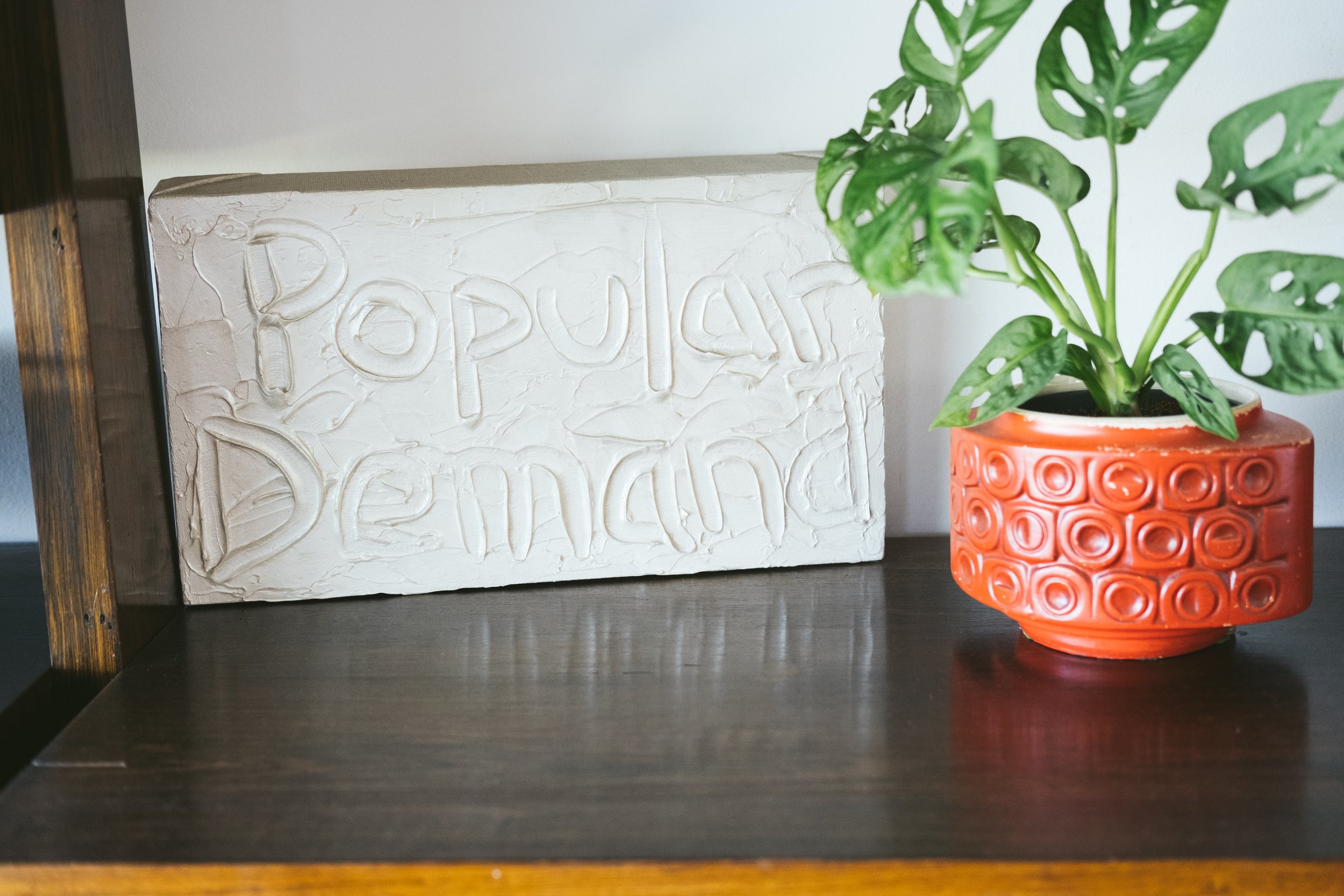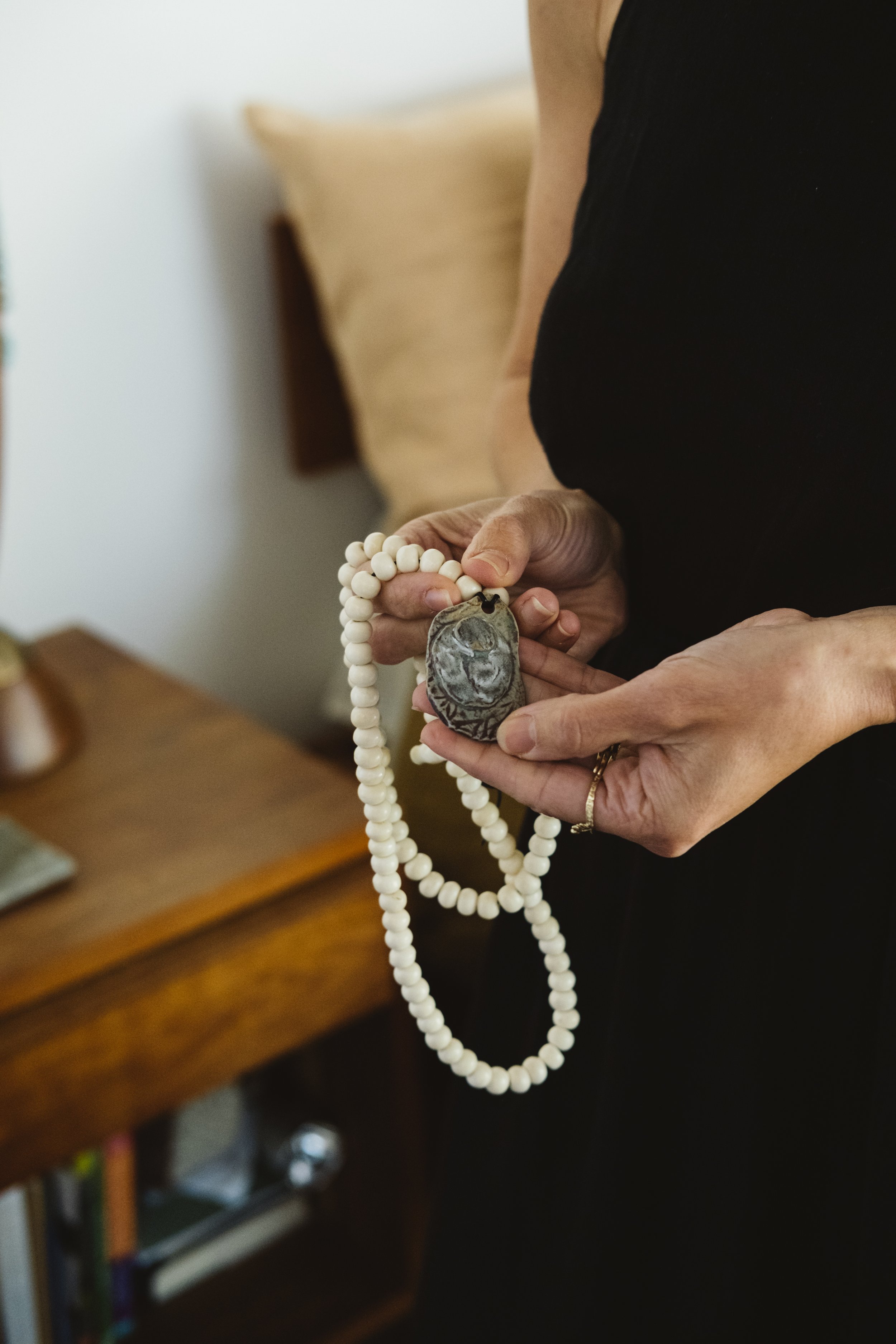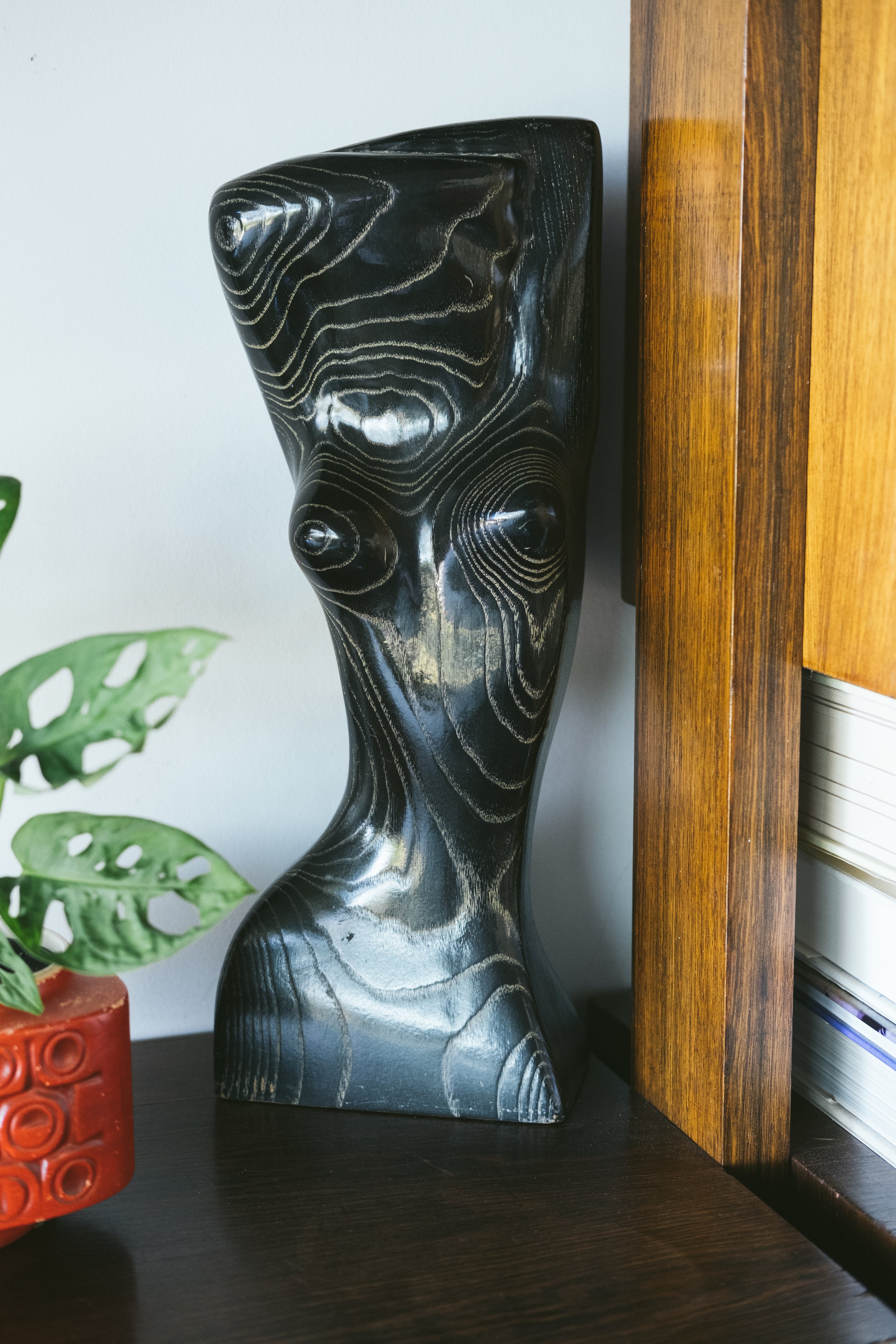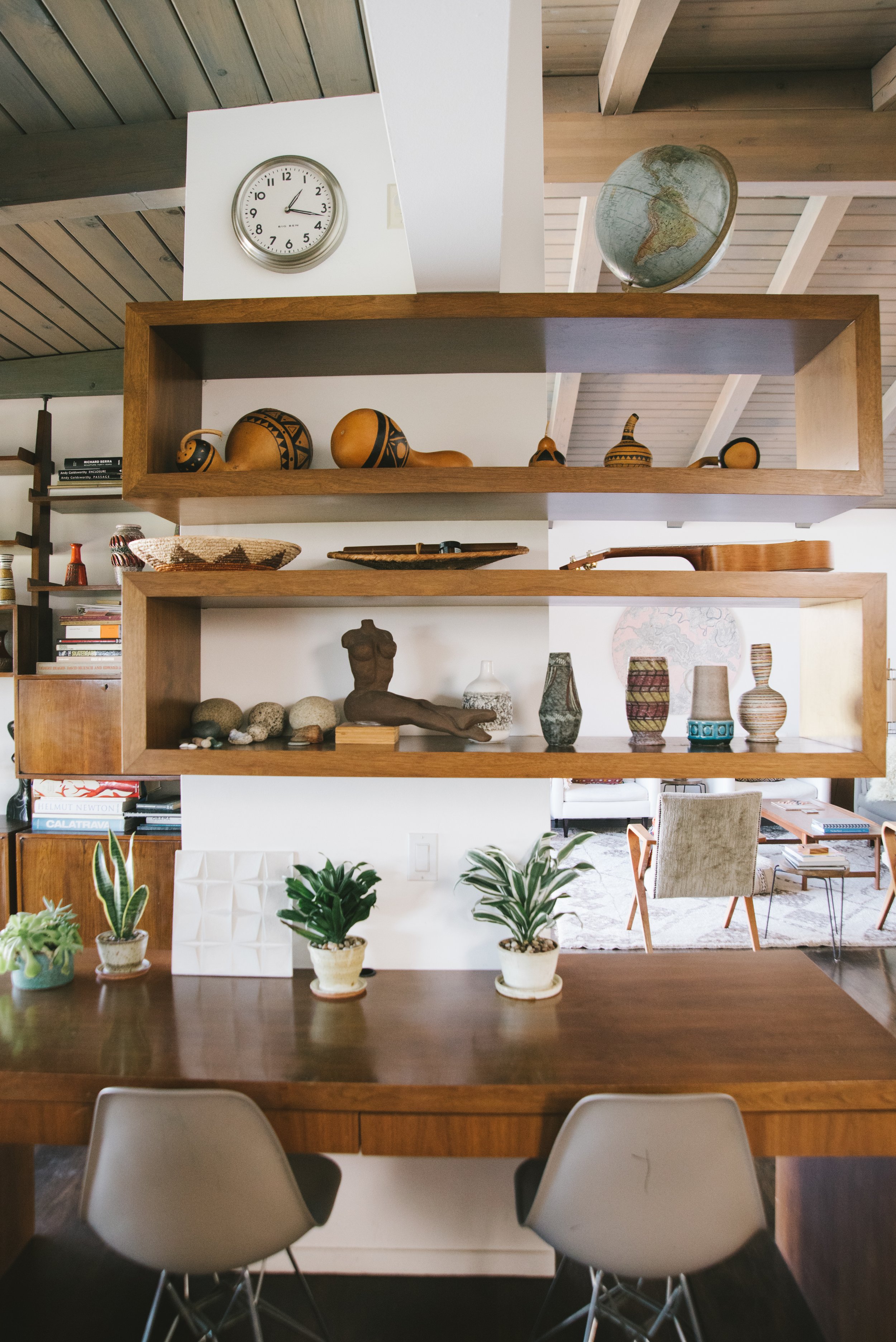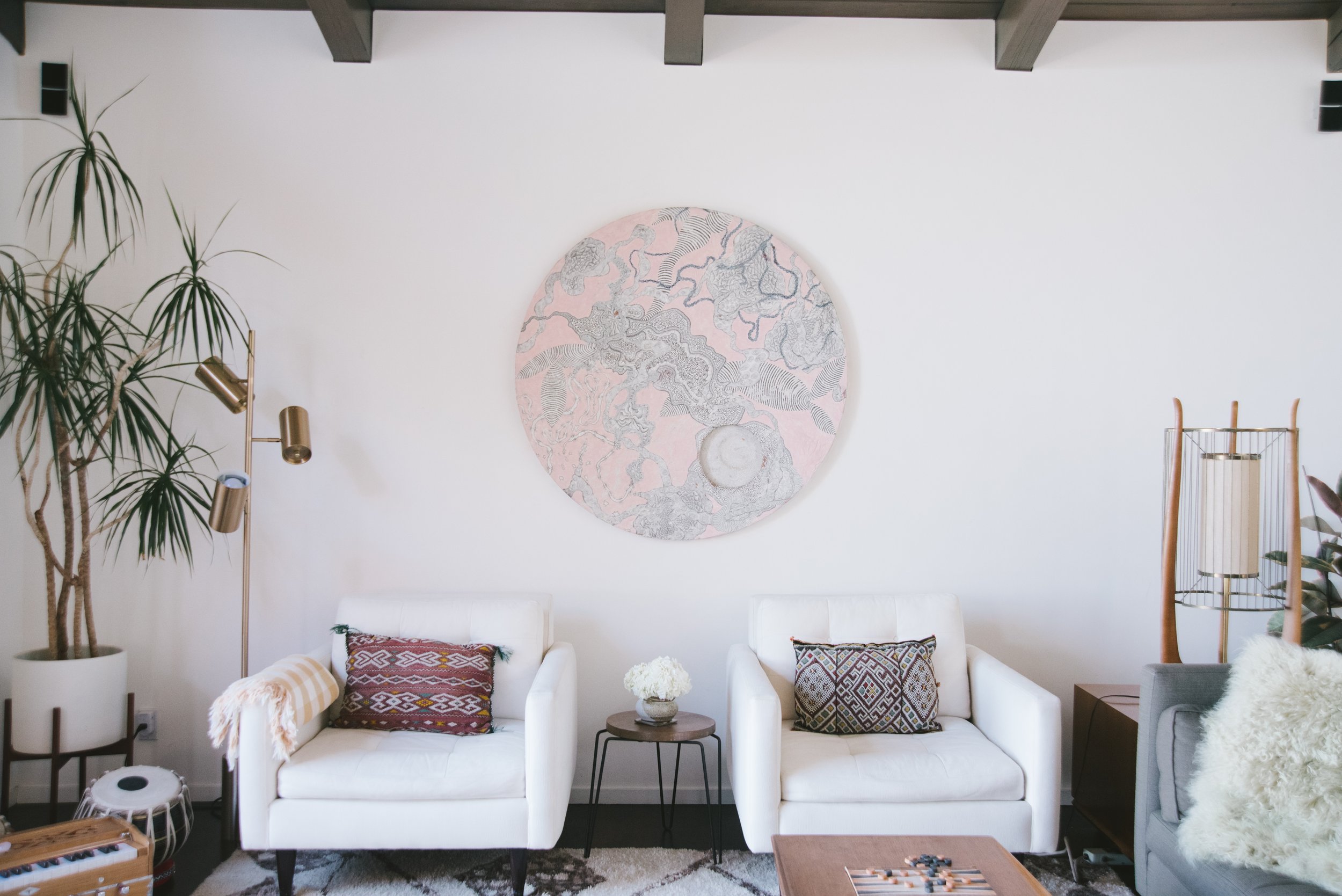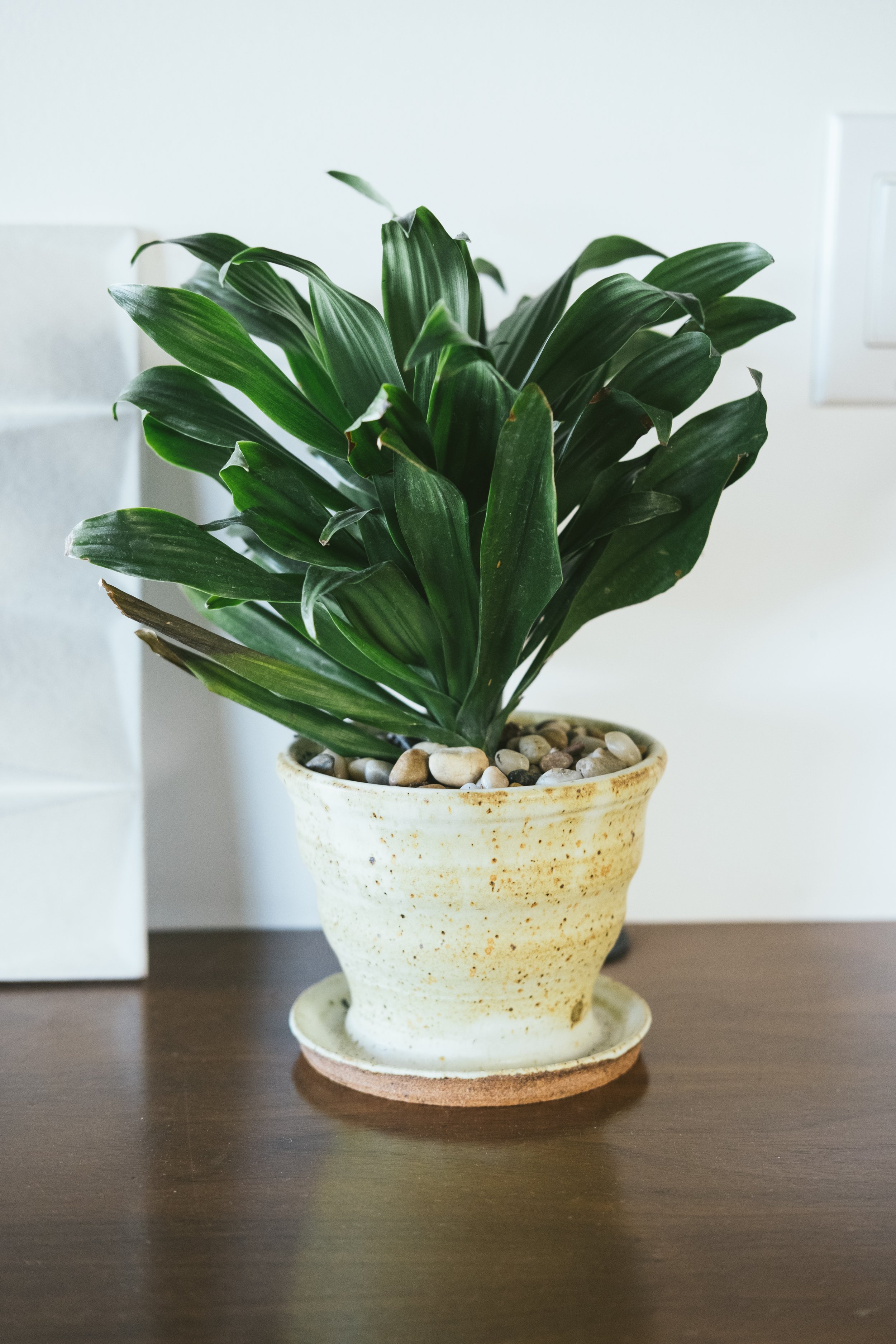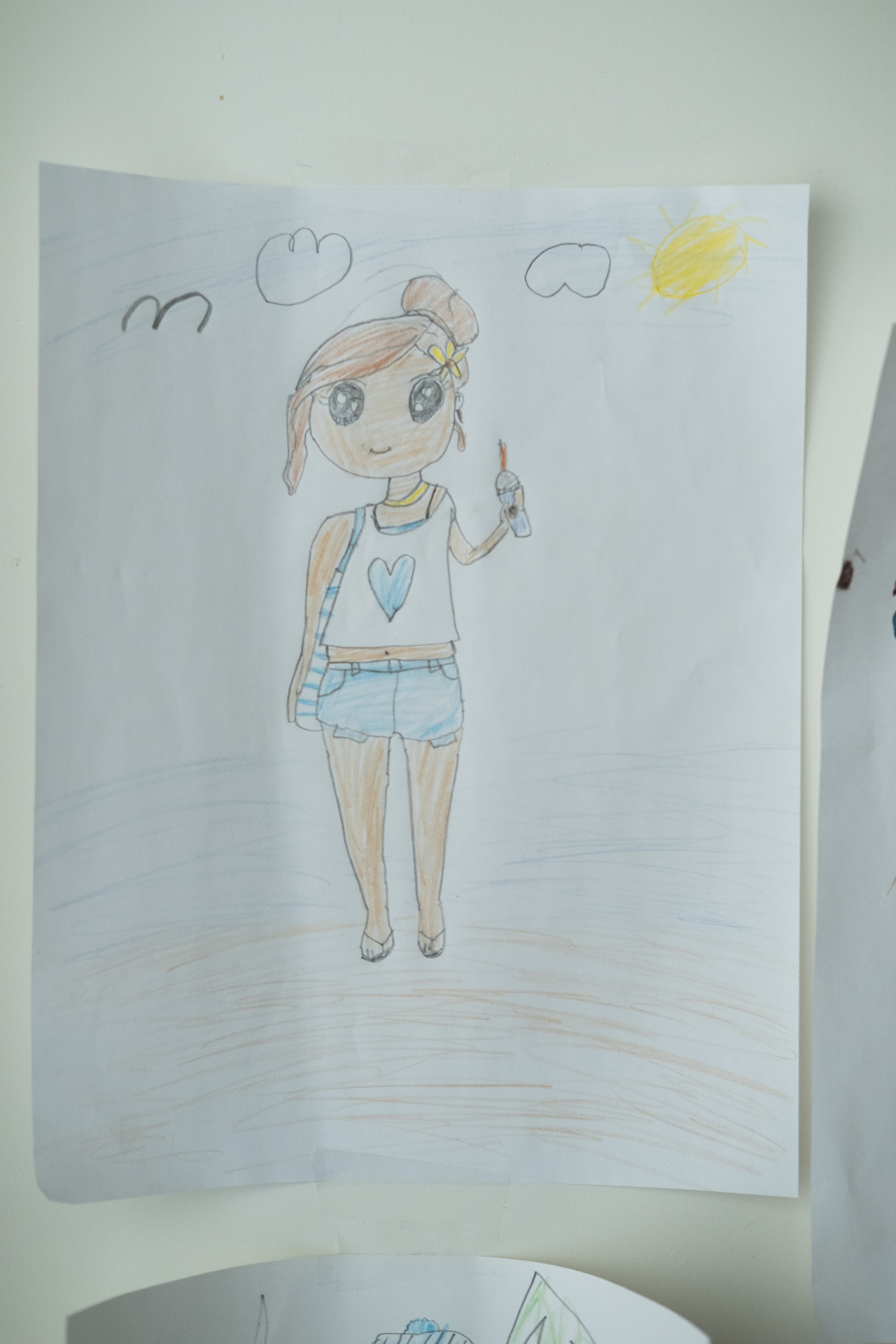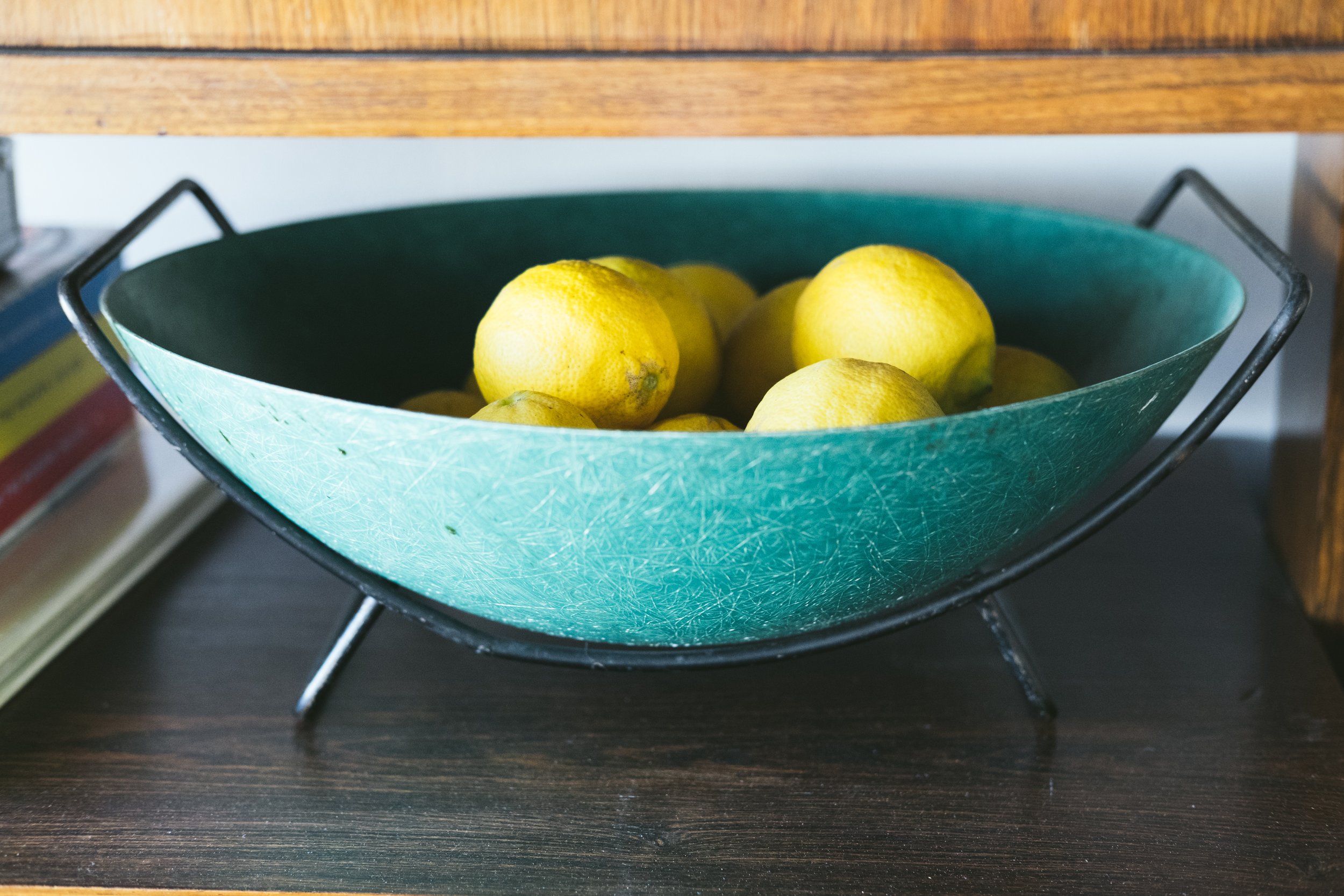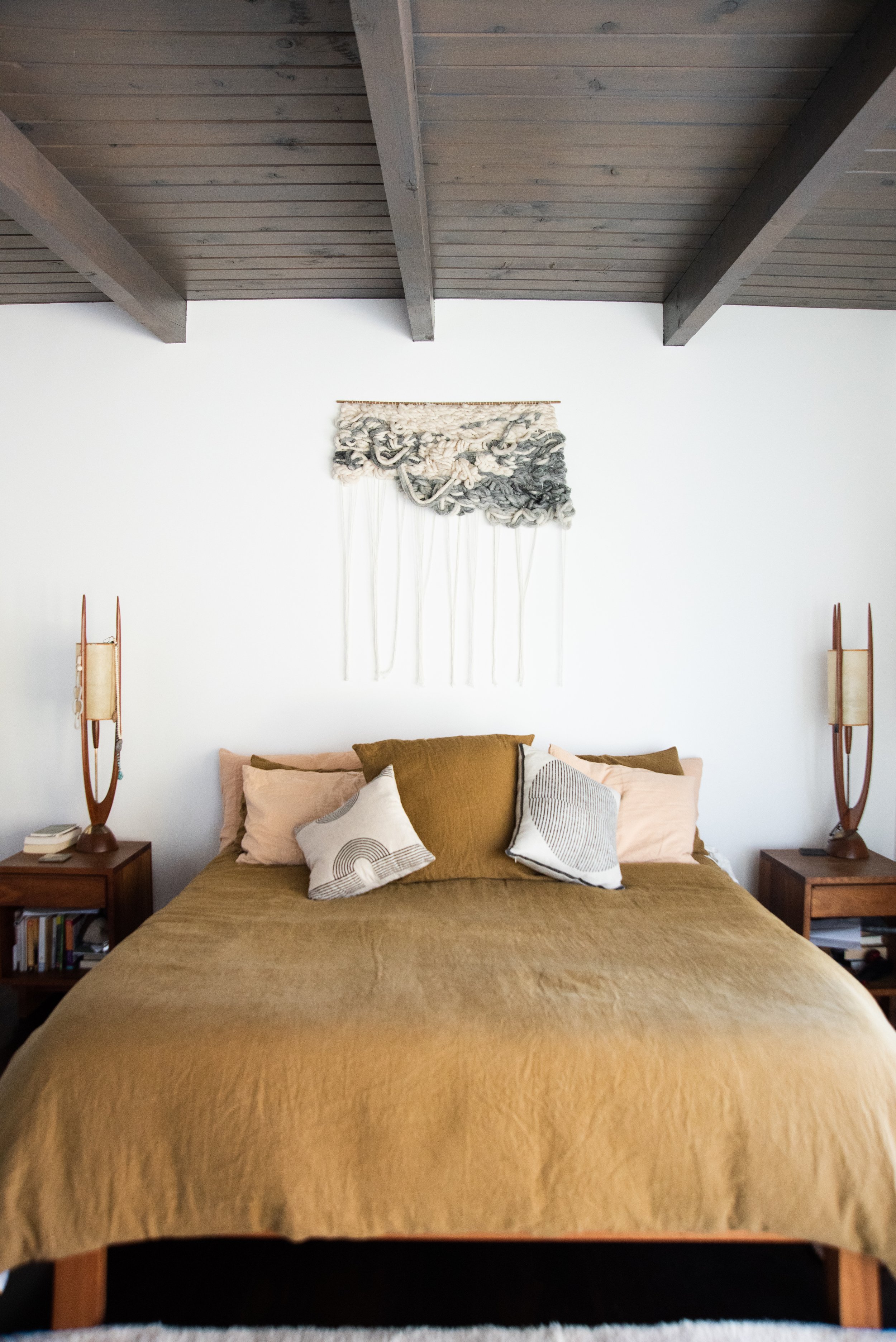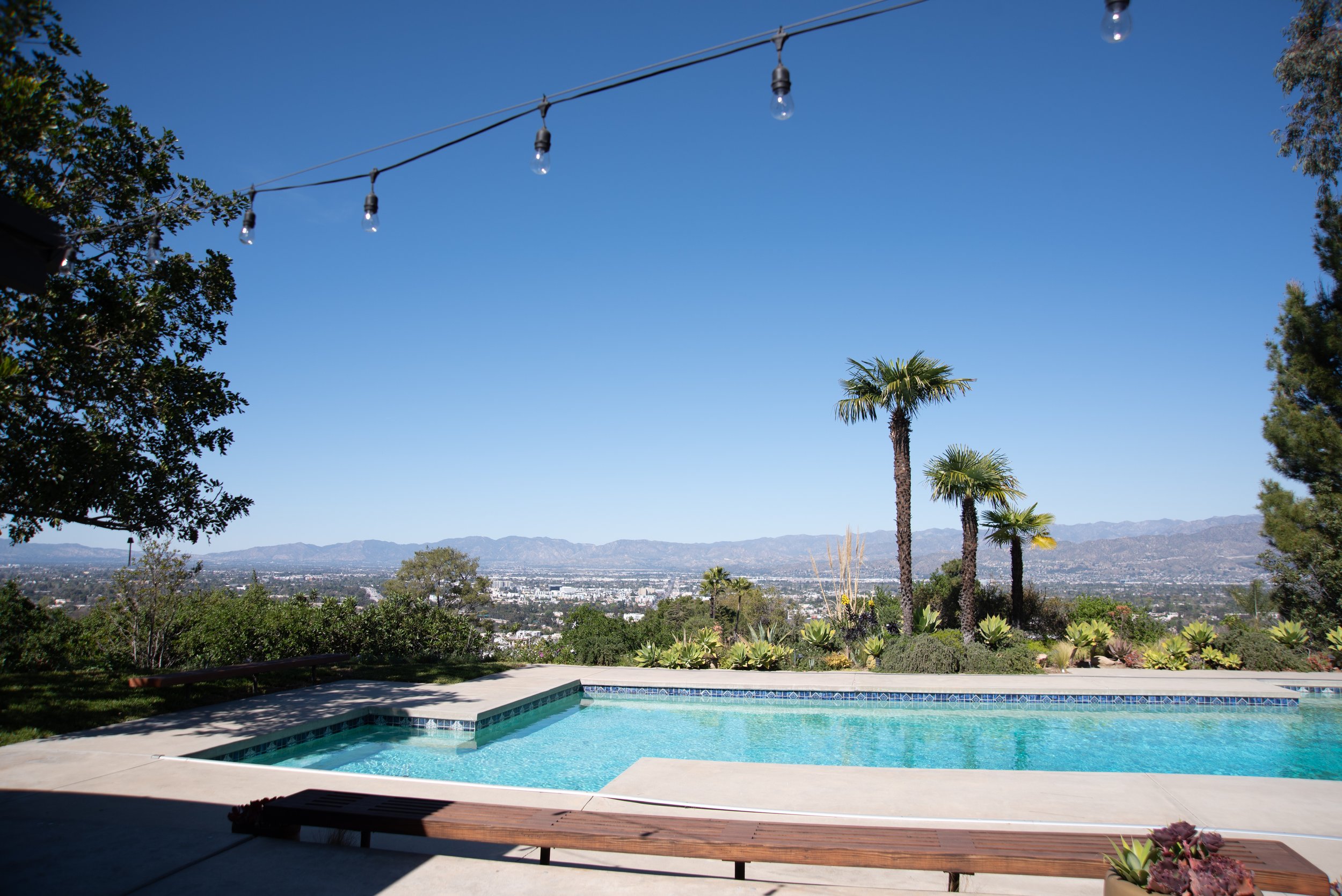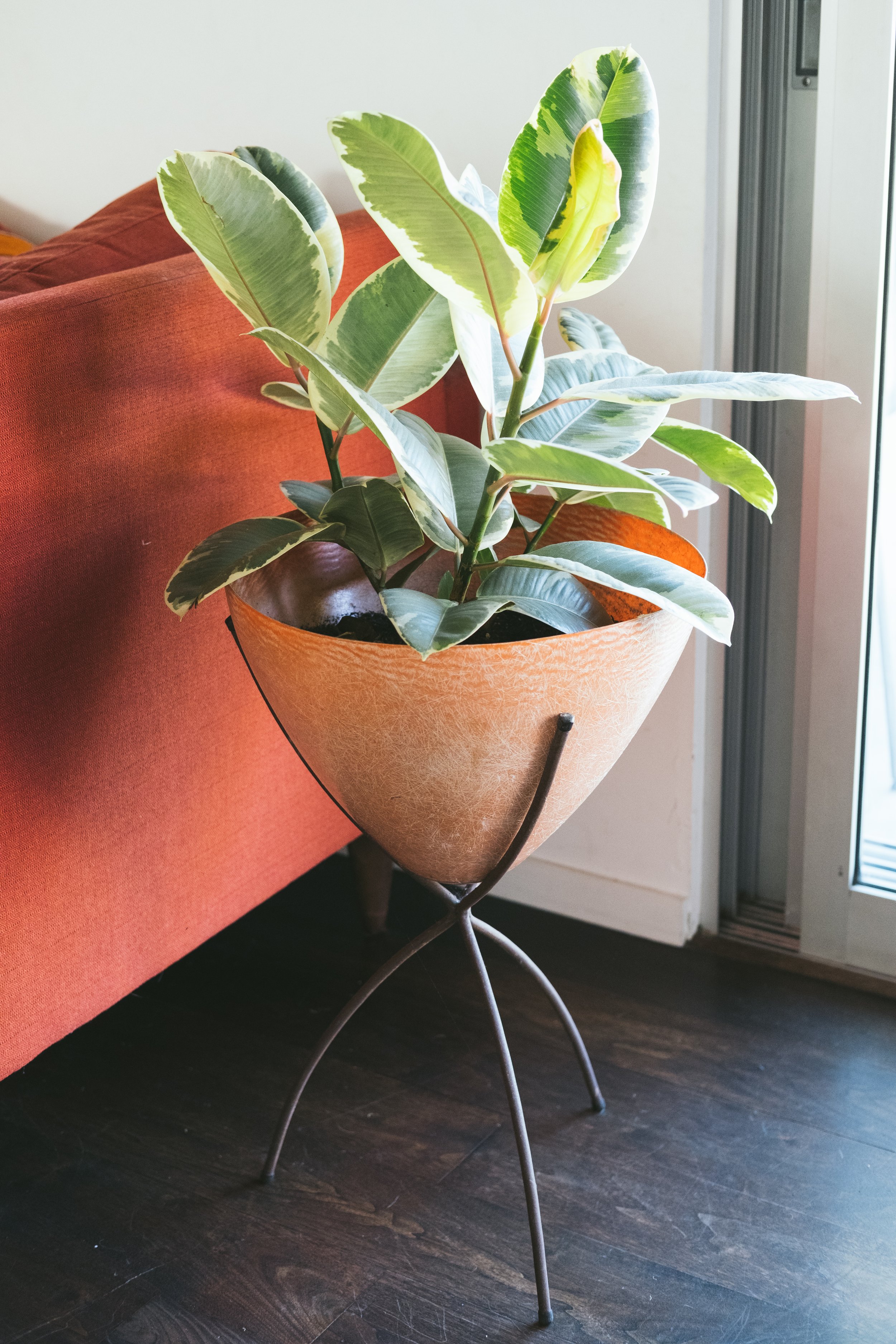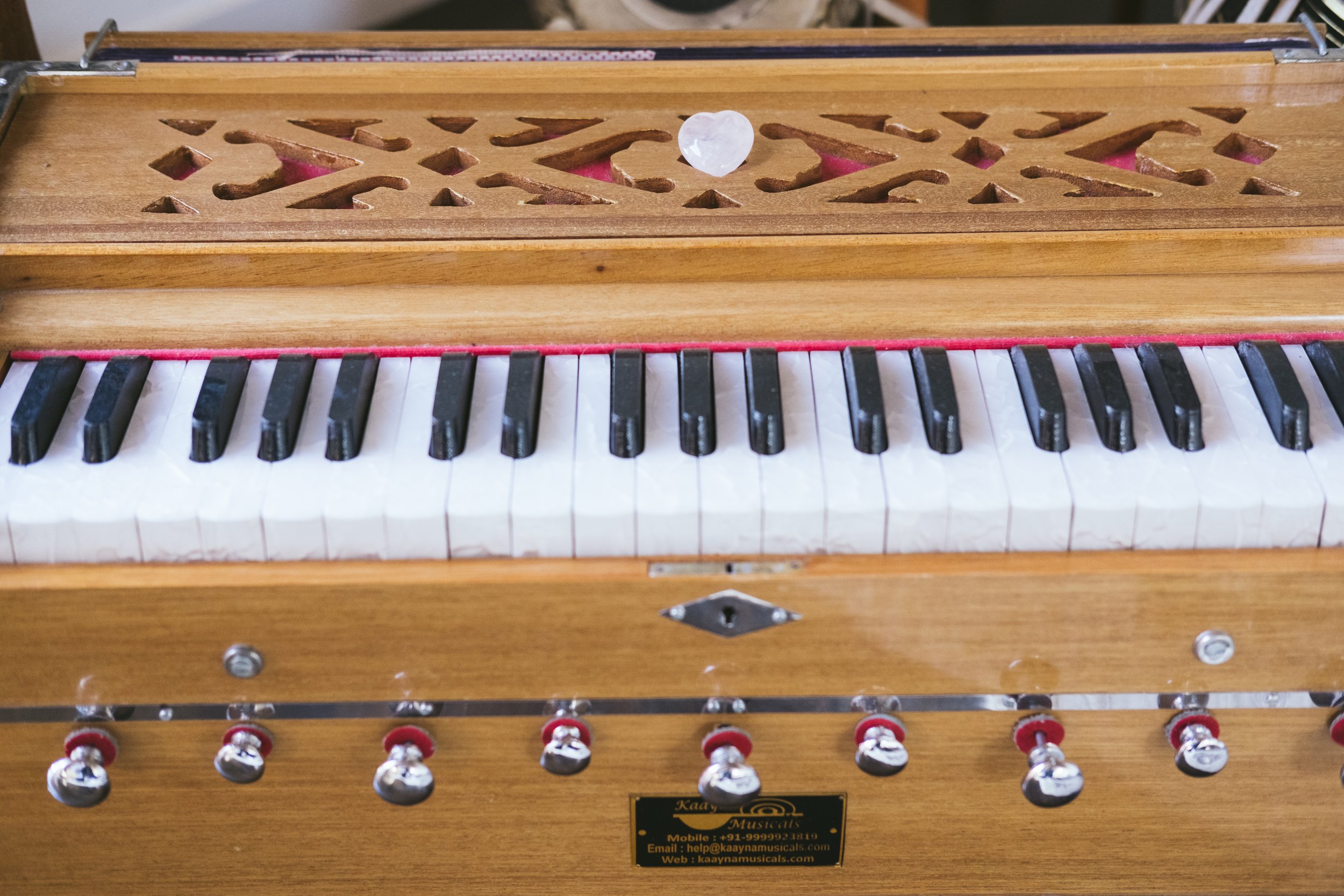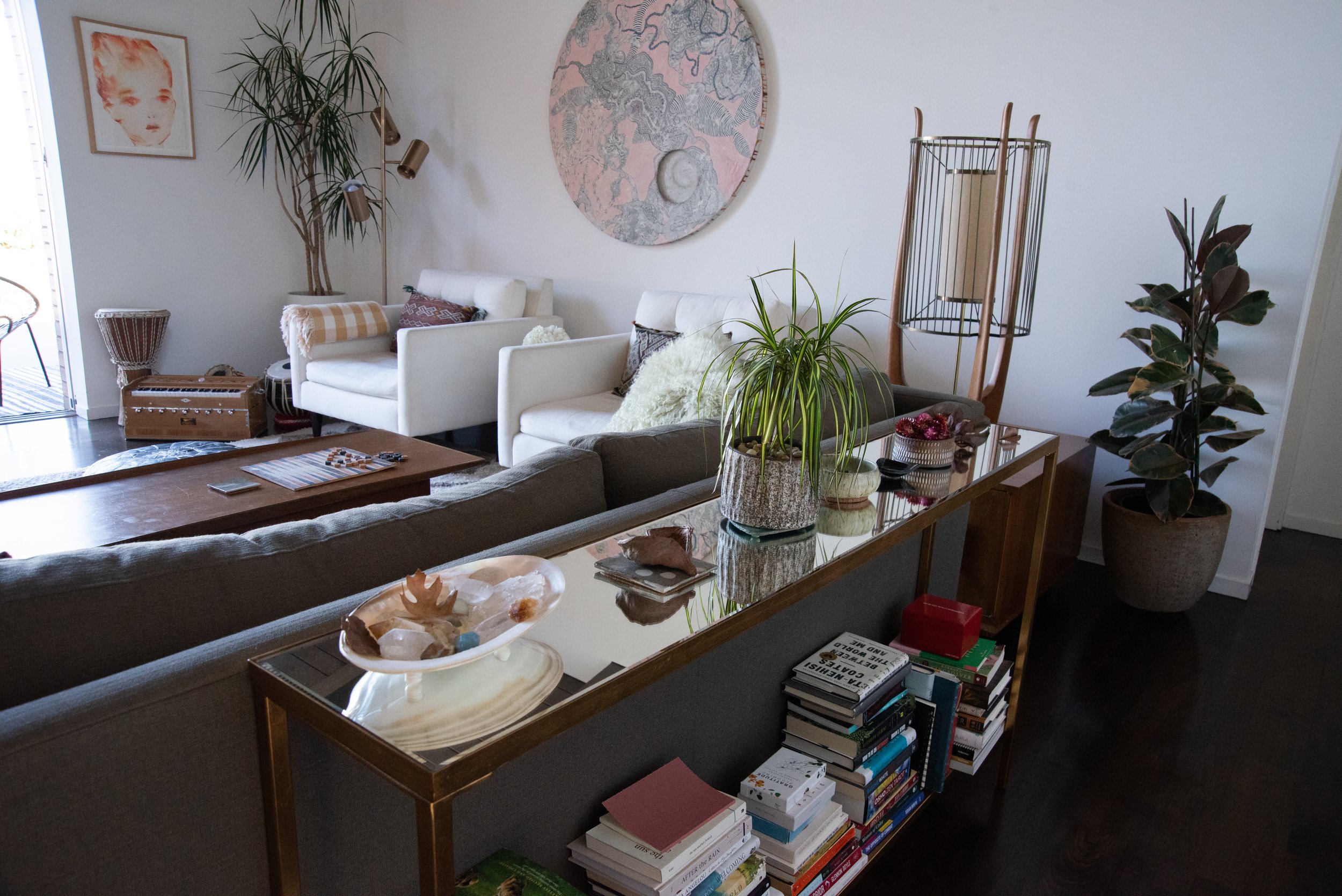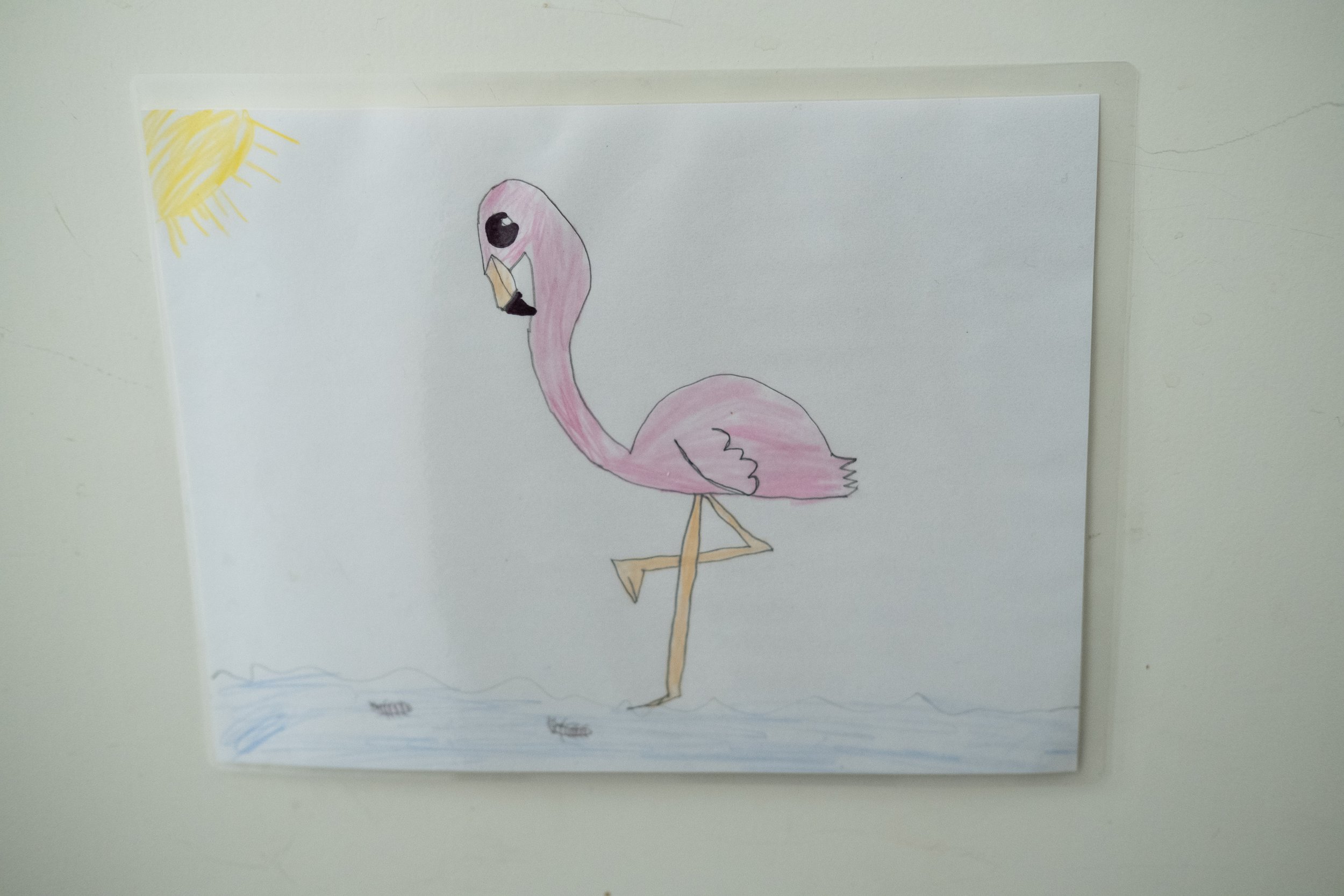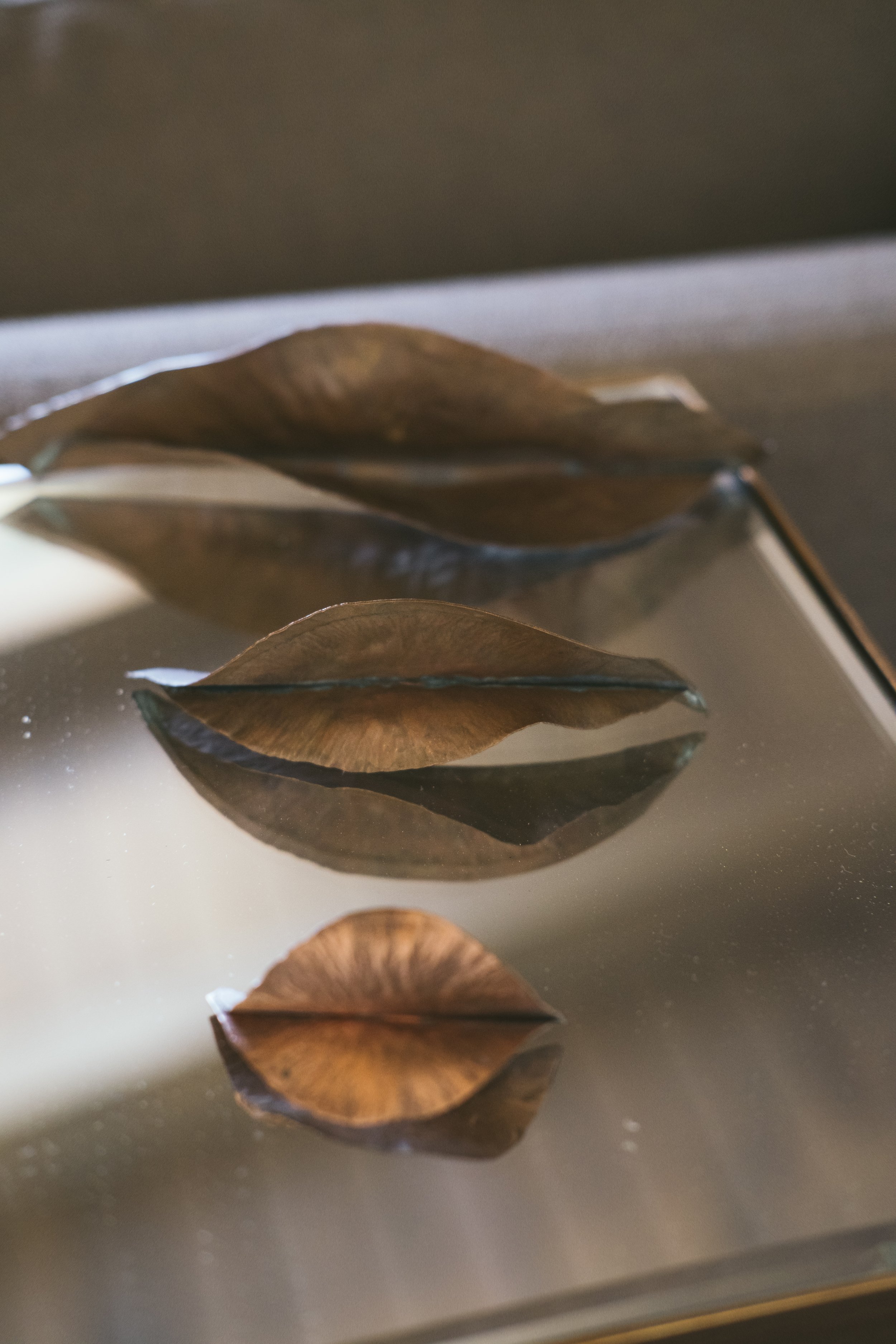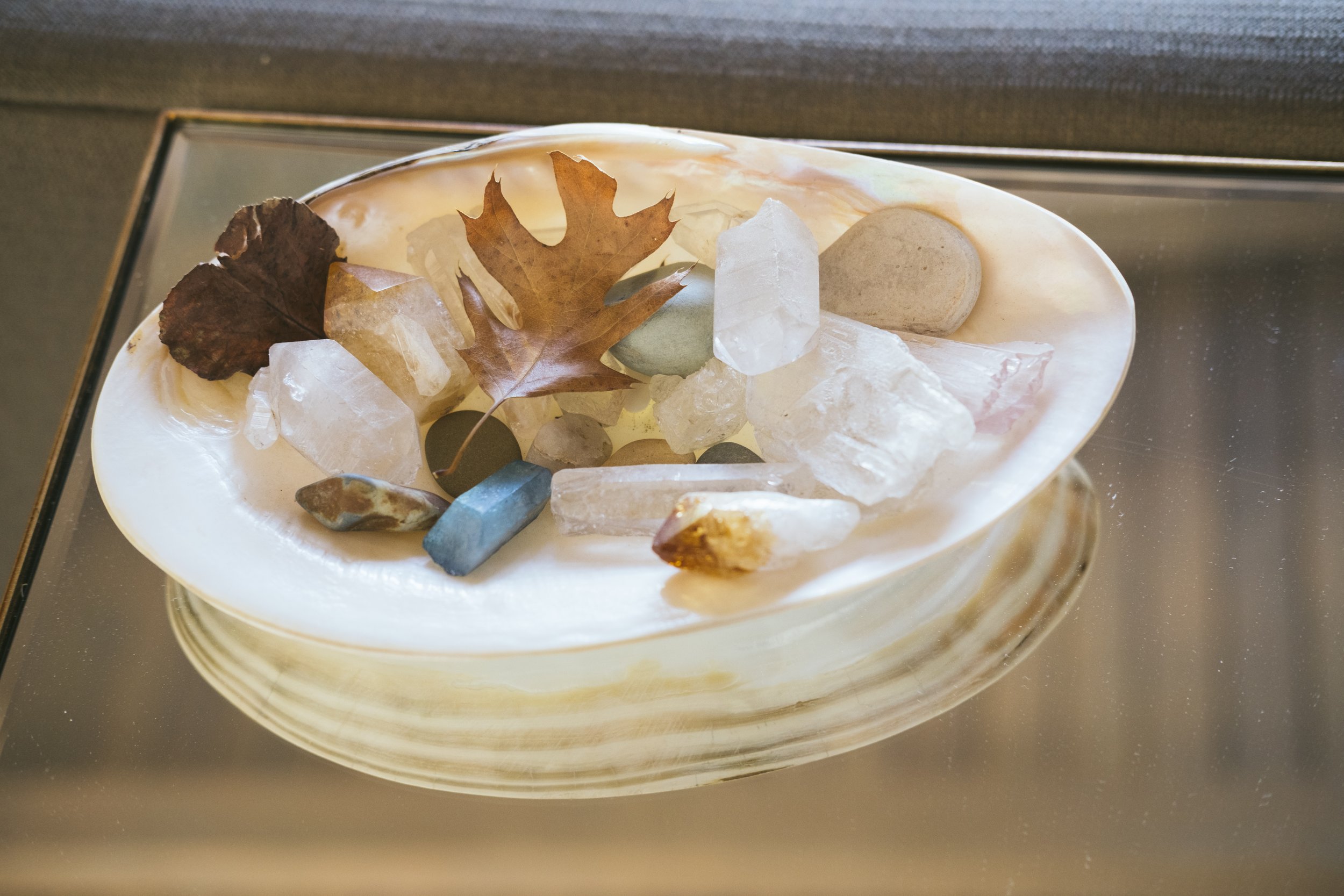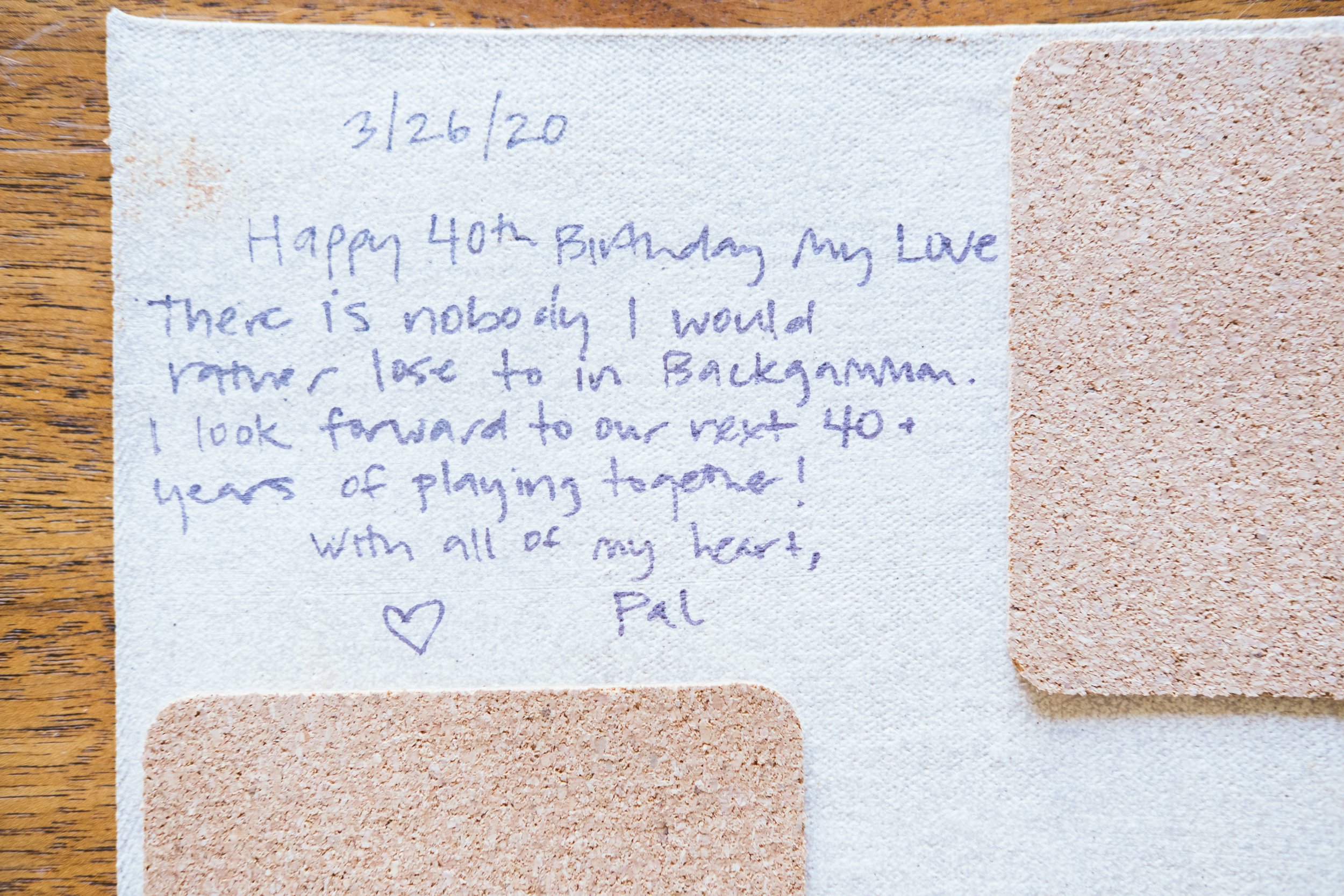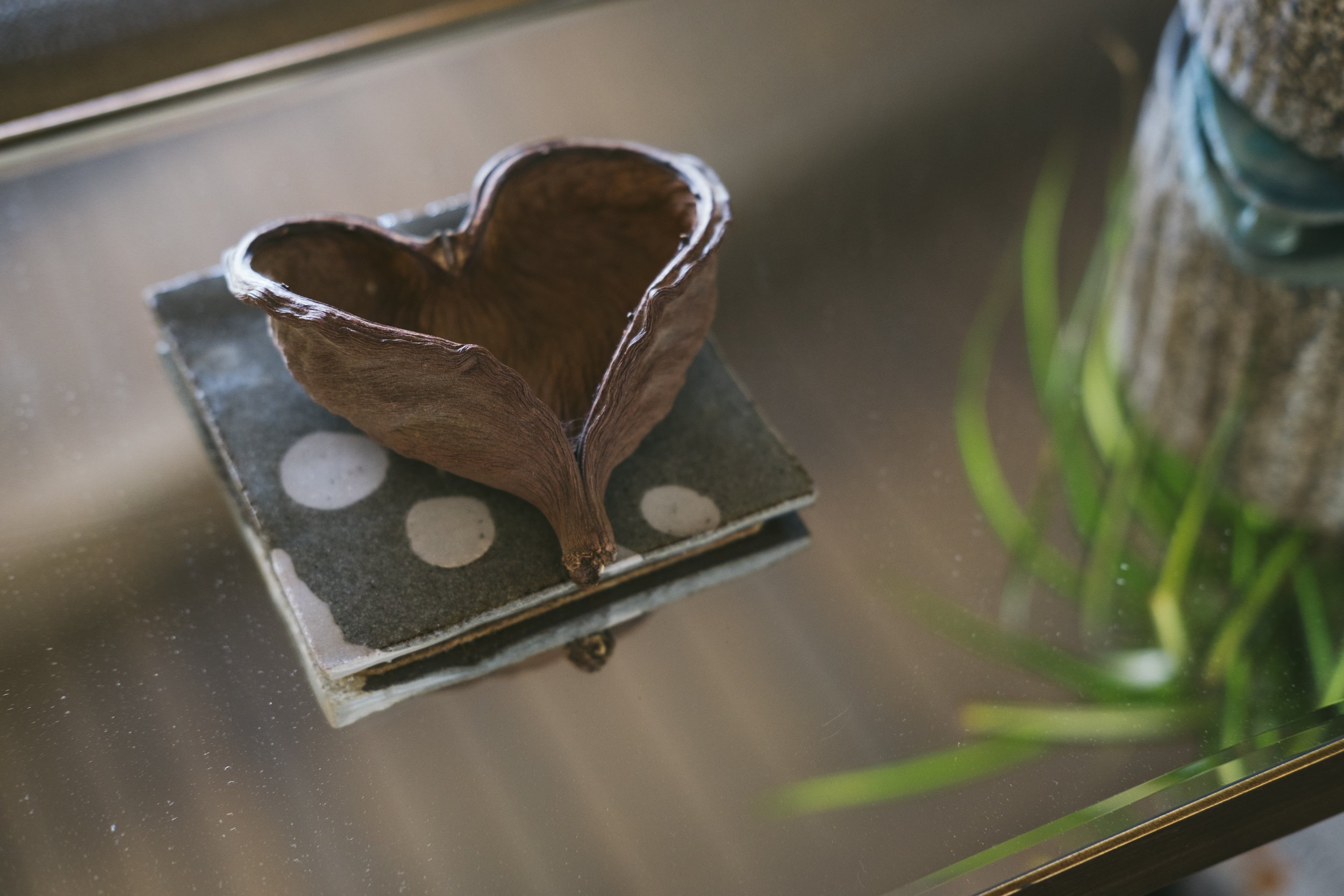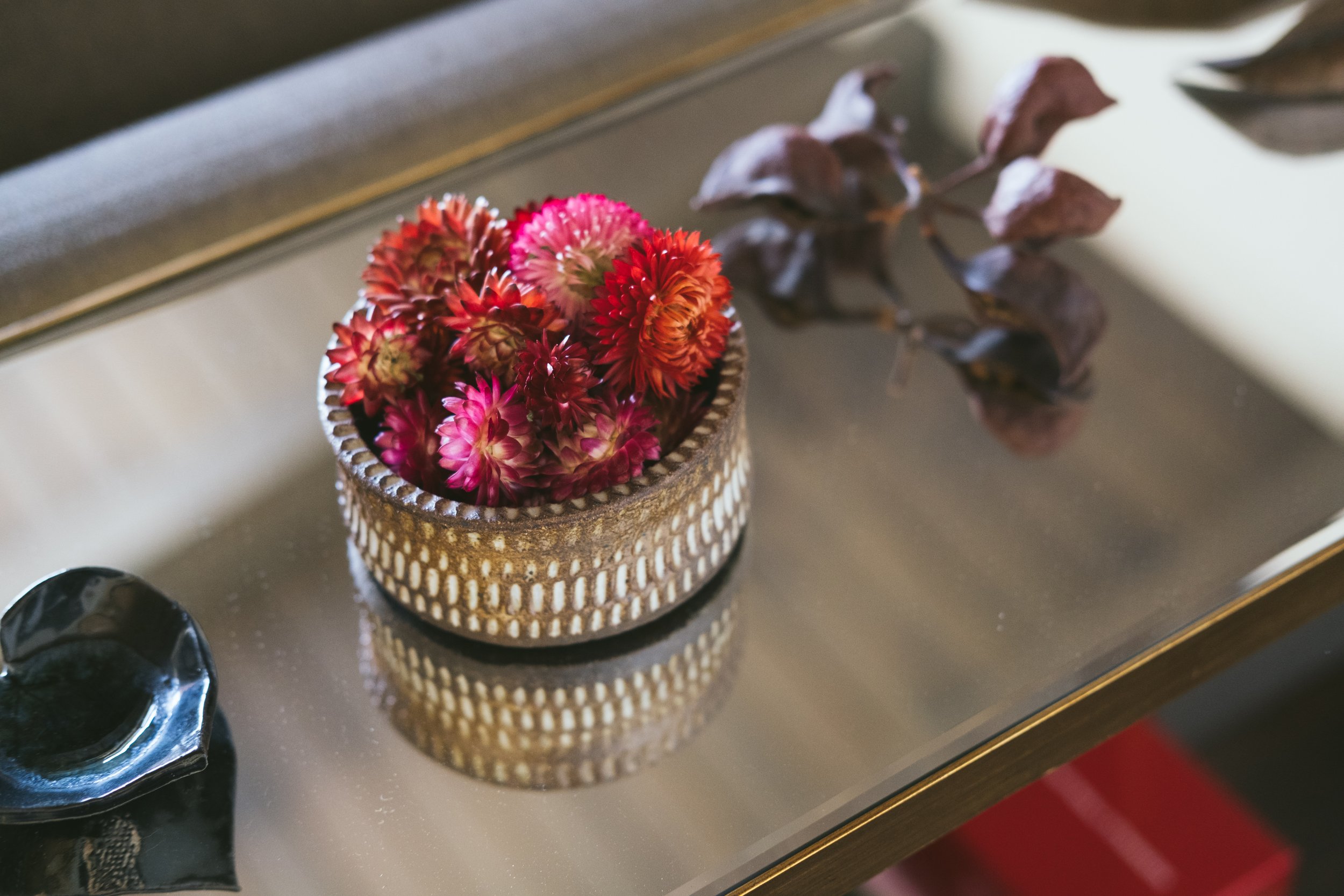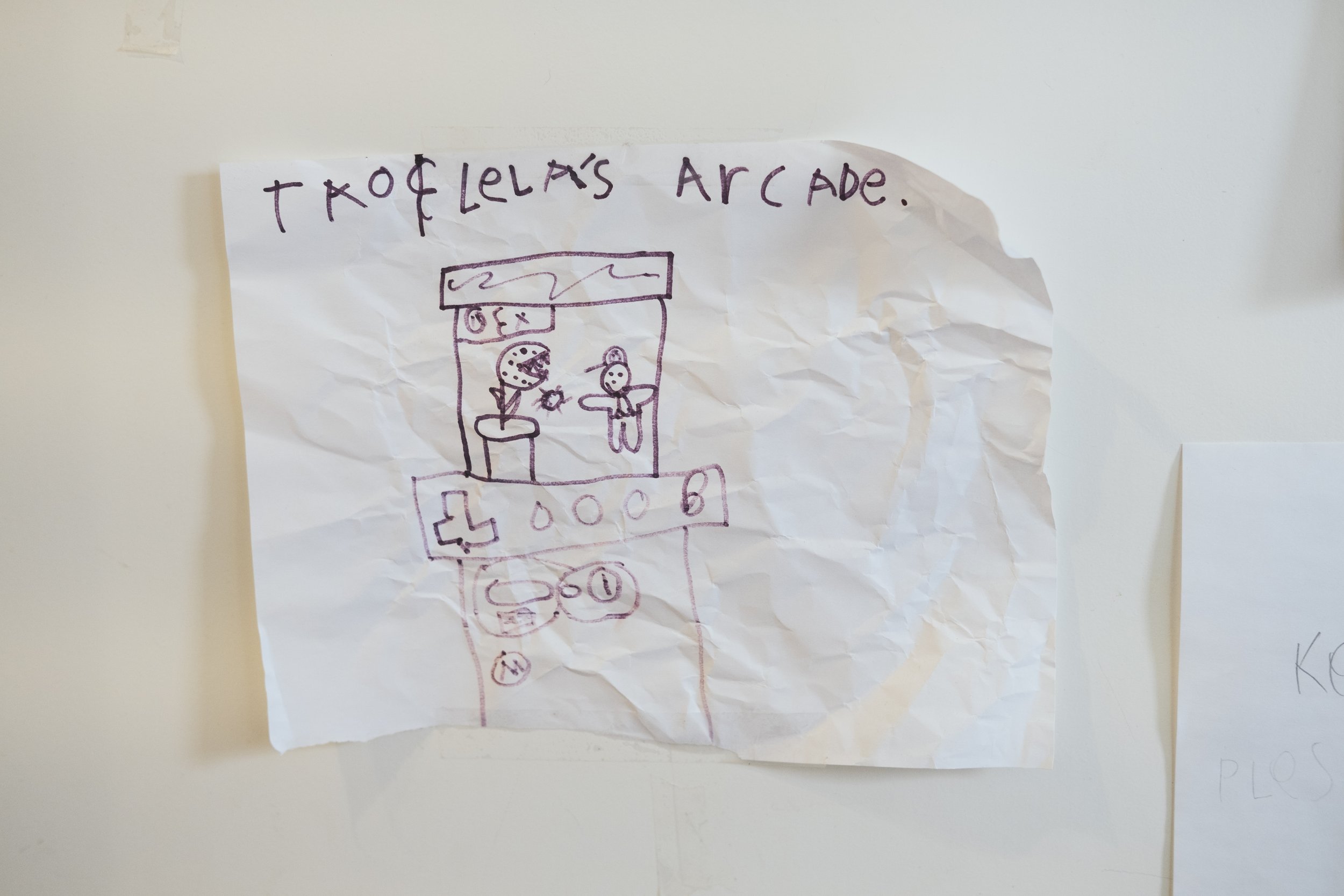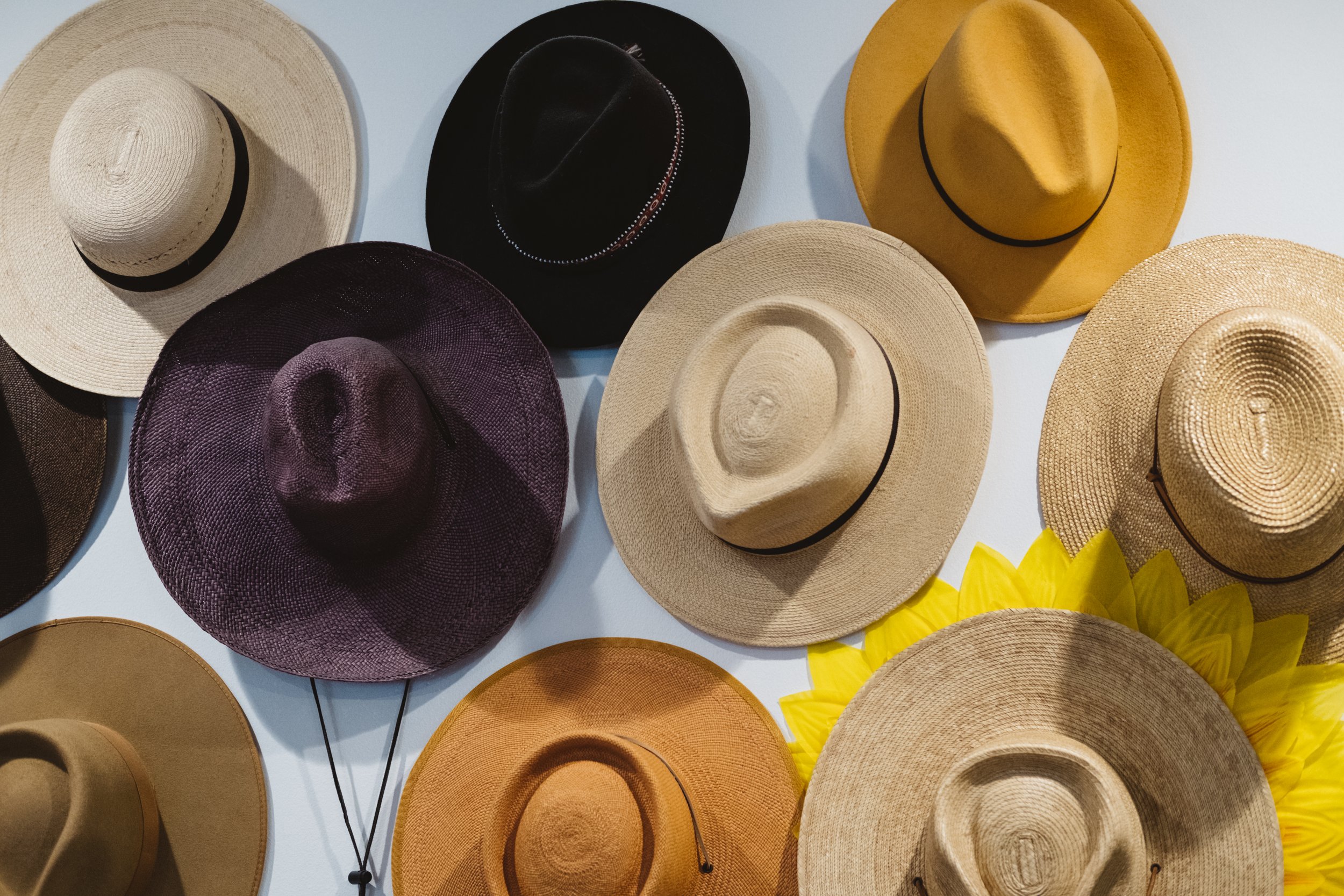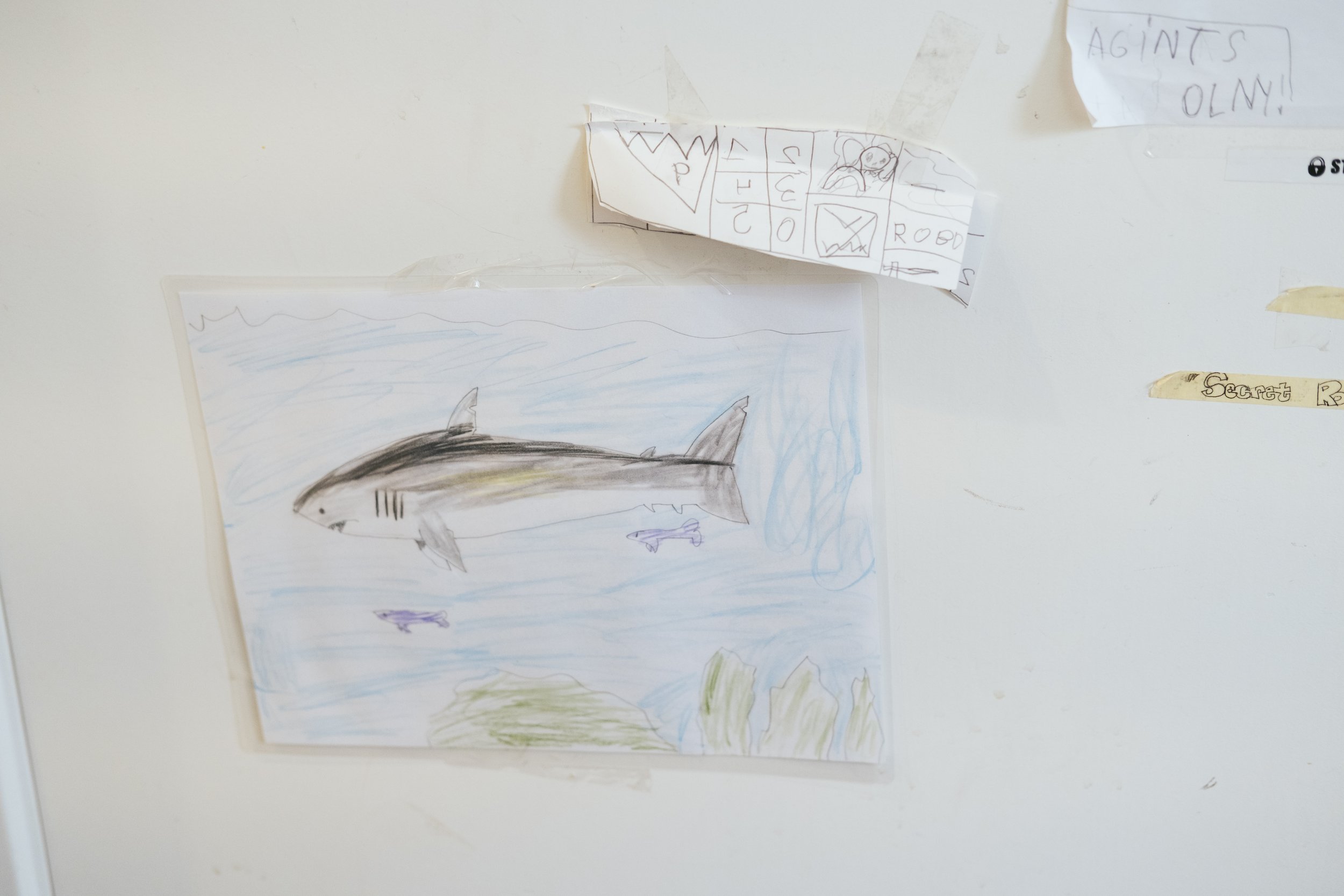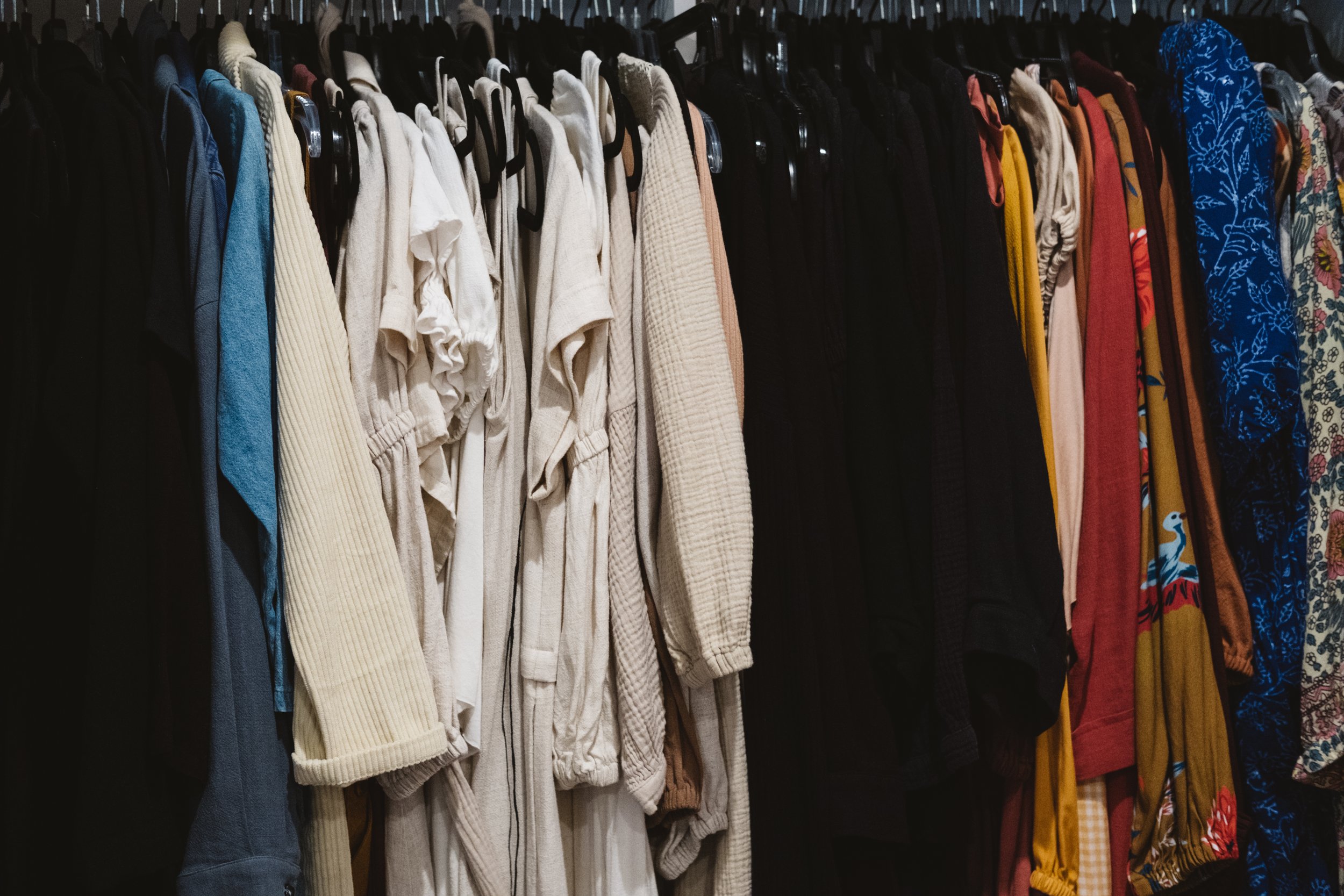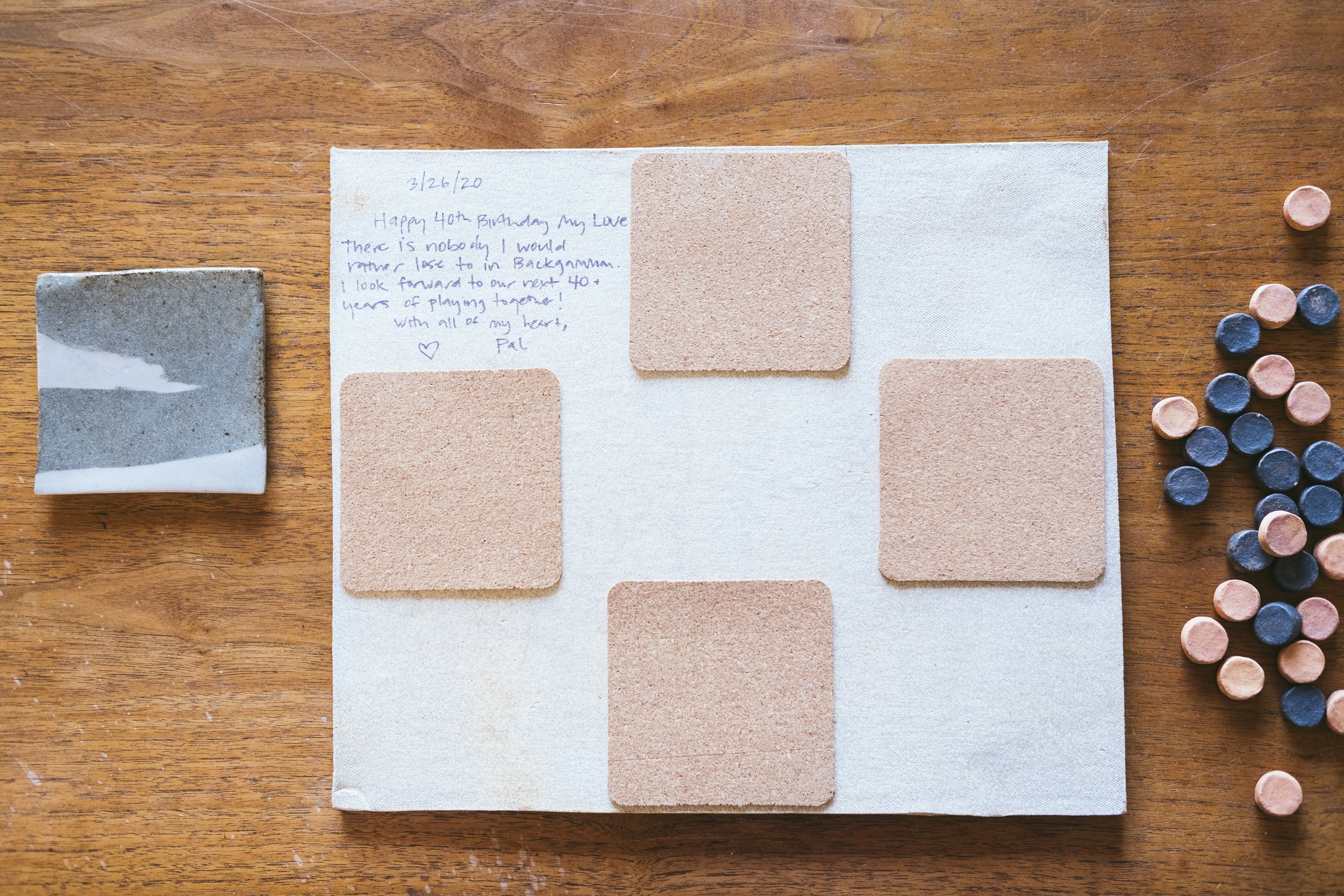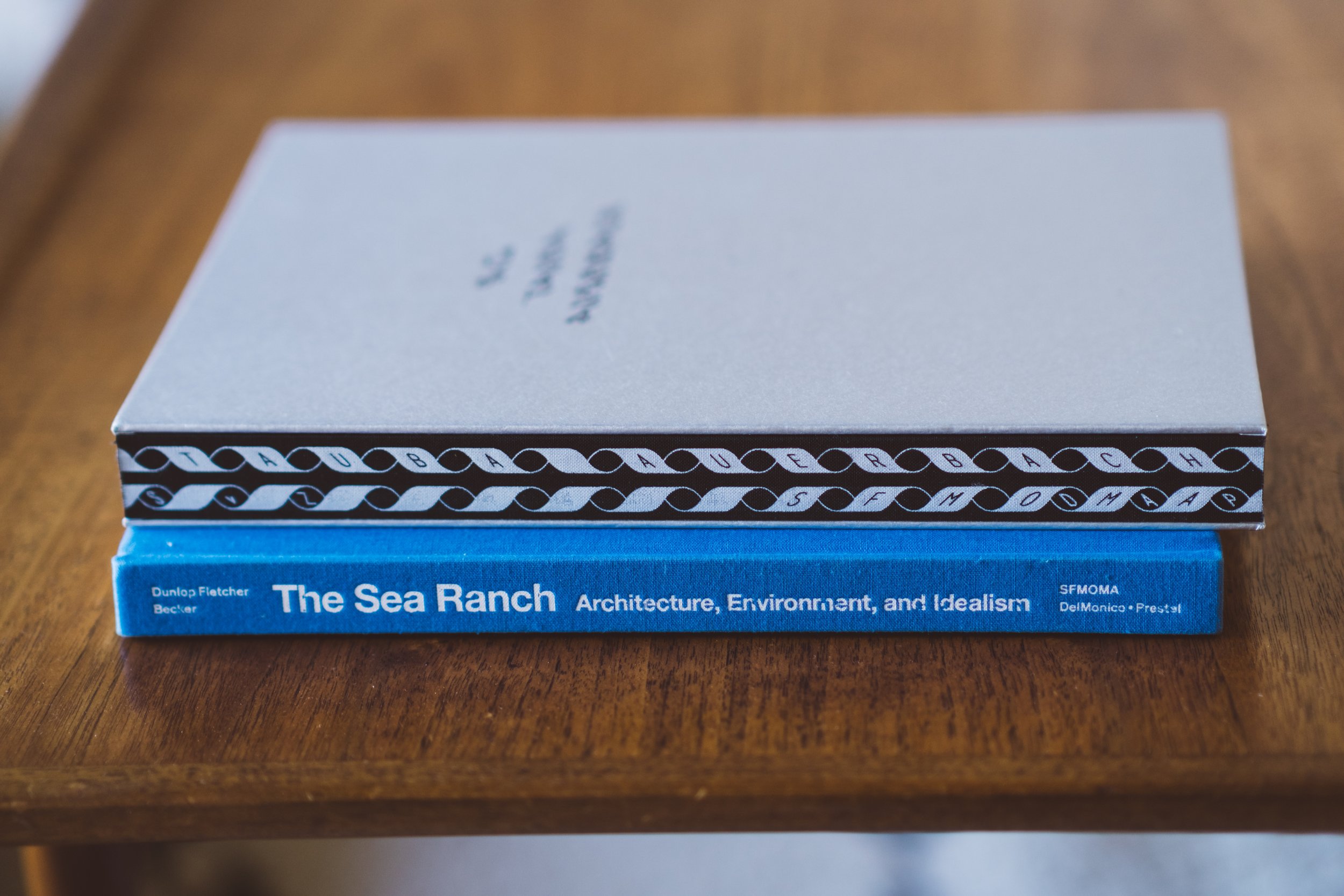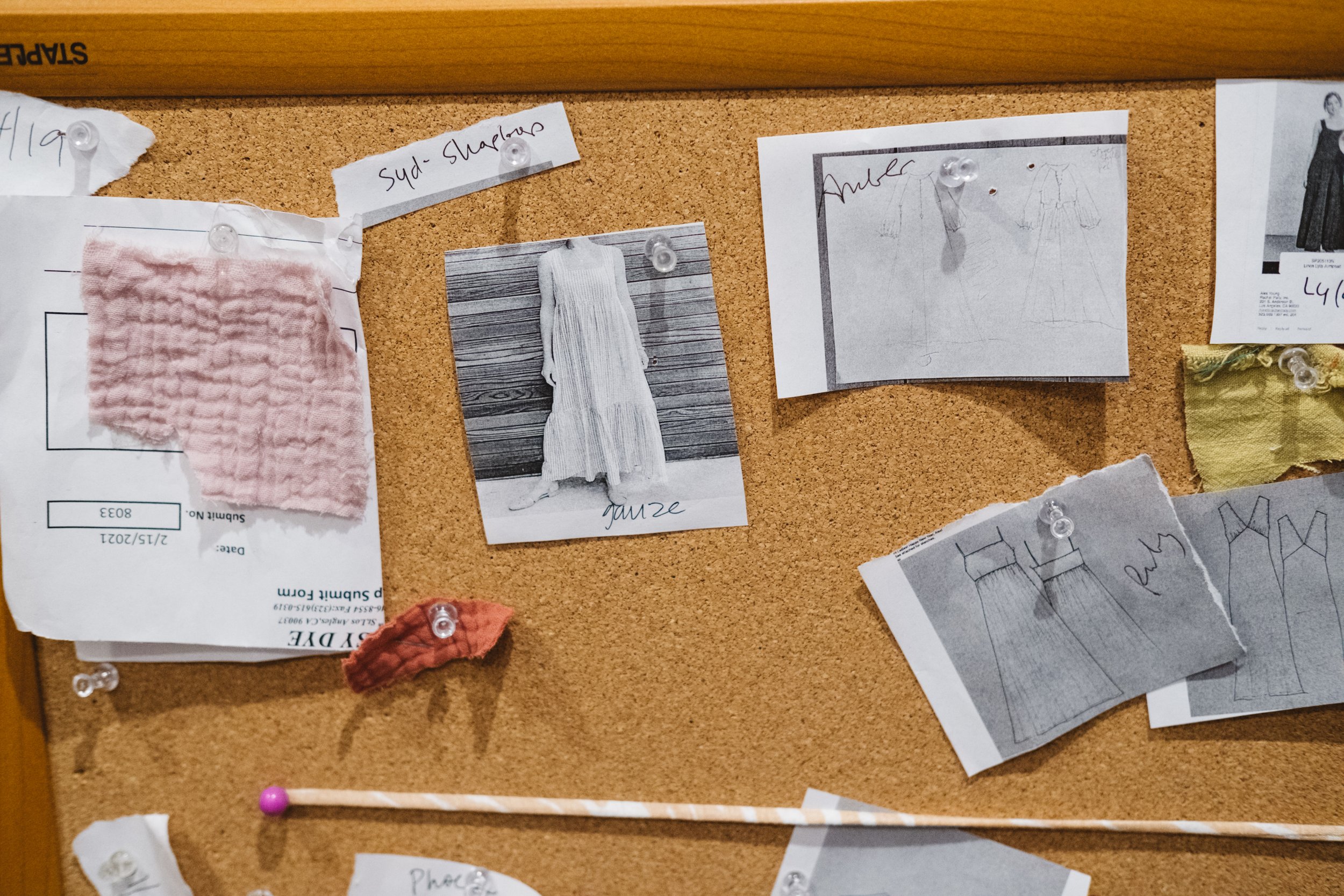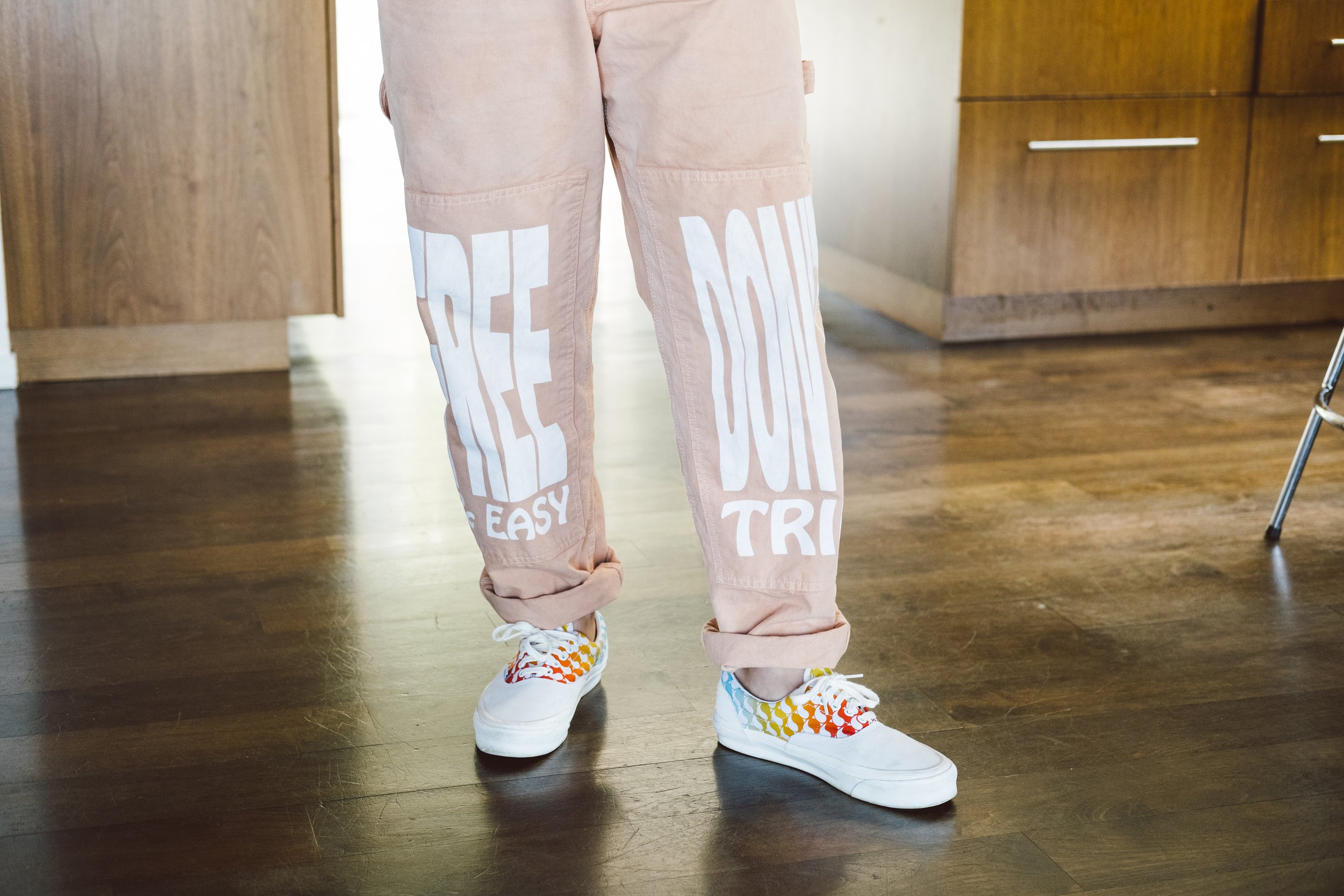Rachel Pally
The L.A. designer discusses overnight success, motherhood, and life with her husband Kevin Circosta.
By Lindzi Scharf
Photography by Birdie Thompson
Few people are overnight successes. Rachel Pally is the exception. The fashion designer launched her eponymous clothing line with a small capsule collection in 2002. She immediately found herself in the big leagues.
“The business grew fast and I was young,” Pally says, explaining Jessica Simpson had worn one of her designs on MTV, which led to major retailers clamoring to carry her collection. “I remember I was 23 and sitting in a room with my lawyer and two of his colleagues putting together a living trust, a will. It was so weird. It was such a grown-up thing to have to think about.”
Looking back, Pally says she's appreciative of her early success but admits that period of her life was dizzying. “It was a weird way to spend my twenties,” she says. “Part of me resented those years of being so [focused on work]. All my friends had their twenties and my twenties were spent working my ass off, but I also had this incredible success and freedom, and financial independence. … Jessica Simpson in those pants bought me my first house.”
Twenty years later, Pally’s business is thriving, but that’s not to say there haven’t been challenges along the way. “I’ve had a lot of life in these last twenty years,” Pally says as birds can be heard chirping from inside her open-air Studio City home. “It’s been up; it’s been down; it’s been up; it’s been down again; and again. It is definitely not a vertical trajectory.”
Evolving her brand’s aesthetic and its early aught association have been among Pally’s key tribulations. It’s a path she’s navigated alongside her equally creative husband Kevin Circosta, who has a successful clothing company of his own.
(Side note: The couple met in pre-school and their L.A. love story is the stuff romantic comedies and meet-cutes are made of. But more on that later.)
As the founder of Free & Easy, Circosta’s brand has a slew of stylish fans including LeBron James, Harry Styles, John Mayer, and the late Mac Miller.
While the duo’s clothing companies and their demographics couldn’t be further from one another, the brands complement each other as perfectly as the couple itself. While Pally’s label is focused on the easygoing Cali girl who “just woke up this way,” Free & Easy’s pieces are a nod to the state’s surf, skate, and sports culture. In short, it’s easy to envision the Pally customer dating a Free & Easy dude – mainly because both brands are organic extensions of their founders and share a relaxed, quintessential California ease.
In plenty of circles, Pally and Circosta would be seen as the epitome of cool. But their young kiddos (Tao, 9, and Luca, 6) don’t see it that way.
“We’re like, ‘We’re cool for a living. Why won’t you listen to us?’” Pally says, laughing. “Tao is like, ‘You’re not.’”
“Tao used to be the creative director of Free & Easy,” Circosta jokes. “All he wore were the t-shirts.”
Pally interjects, “Not anymore.”
“Soon enough, he will come around. It’s his version of rebellion. I’m like, ‘Bro, I promise you, I’m not guiding you in the wrong direction.’”
“He’s trying to make his own way.”
It’s a right of passage for any kid. Pally and Circosta were no different.
AN ARTISTIC UPBRINGING
Born and raised in Los Angeles, Pally grew up observing her parents who owned and operated Gymboree play programs in the community. “My parents worked their butts off and were consumed by it,” she says, “but it allowed our family a great deal of flexibility” to pursue their many creative passions.
“My whole family are artists,” Pally says, explaining that her dad is a musician; her mom, she says, “did it all;” her brother; her uncle, her cousin; and the list goes on. “My [maternal] grandma is a sculptor and a potter,” she adds. “Art and activism are in my family. It would be great if we had a doctor or a lawyer, but we don’t have a single person who is.” She pauses. “We have one lawyer and she works for a [company doing philanthropic work].”
Pally grew up playing guitar and dabbling in various creative mediums including pottery and sewing. “In addition to being a singer, my dad’s mom was an amazing seamstress,” Pally says. “I did some sewing projects with her when I was a kid.”
However, Pally’s passion for design came much later. “I was into fashion when I was a teenager,” she says, explaining she preferred vintage clothing at the time. “I would call it vintage and my mom was like, ‘No, it’s just used. You can’t put a pretty word to that. Those are men’s polyester pants and they’re terrible.’ I would buy expandomatic pants at the Jet Rag dollar sale on the weekends with a vintage t-shirt. It was a funny time in fashion.”
THE COLLEGE YEARS
Pally attended The University of California, Berkeley, where she majored in geography and modern dance. “Geography was a catchall for the classes I had accumulated,” she says, explaining she was interested in “city planning, sociology, architecture history, and how people interact with their space.”
At the time, Pally was less focused on what she wanted to do for a living and instead used those years to explore her love of and interest in movement. “College is about trying things,” she says. “I was a good dancer, but I was not going to be a star. It’s such a competitive world. There’s also such an unhealthy focus on bodies and perfection and that’s not at all my thing. That’s why I loved African dance because it was about movement and not about size.”
Pally revisited sewing as the result of a college requirement. “I had to do a certain amount of hours in the costume [department],” she says. “I started making costumes for dancers and I loved it – the way that bodies move and the way that you drape.”
Pally didn’t have formal training, but improvised. “I was making it up as I went along,” she says. “I didn’t follow a pattern, but I could pin it and then stitch it and it was good enough. I had a lot of fun experimenting with that. Then for my birthday, my senior year of college, my parents bought me a sewing machine. I would go down to the local fabric store and buy whatever was on the sale or dollar rack and started stitching things and making things for friends and we were all wearing it.”
Over college vacation, Pally visited a shop on Chung King Road in Chinatown, Los Angeles, which was a budding art community at the time. She remembers: “A woman at this store said, ‘I love what you’re wearing. Where did you get it?’ I said, ‘I made it.’ She said, ‘Do you have anything else I can see?’ I said, ‘I have my laundry in the car,’ and I brought it in.” Pally laughs. “I don’t recommend this as a business technique but I brought in a bag of my laundry and poured it out on her floor and showed her what I had been making.”
The boutique owner encouraged Pally to make pieces for the store. “I was making things on my kitchen table and sending them to her,” she says. “It was selling, so she said, ‘You’re graduating. You should give this a try.’”
The thought hadn’t even occurred to Pally. “At the time, to work in fashion, you had to be a rich kid who went to NYU and didn’t have to make a living and could work for free at Vogue,” she says, matter-of-factly, before clarifying that wasn’t her circumstance.
But with the shop owner’s encouragement, Pally pursued launching her clothing line. “When I decided to do fashion, it was a surprise,” she admits. “That was not what I thought I was going to do. I thought I would go back to school and be a professor and do something academic. That would not have been the life for me though in retrospect.”
Pally got started by purchasing an overlock sewing machine on Craig's List. “It didn't have a manual and I didn't know how to restring it, but the tailor at the end of my parents' street would [help] me,” she says.
Because Pally launched her business during the pre-YouTube era, she had to research the garment industry the good old fashion way.
“There was a book you could buy from the Textile Association of Los Angeles,” she says. “It was a Xeroxed spiral bound book with a directory of people who did all these different jobs [in the textile industry]. I would go to the buildings downtown, like, ‘Oh, there’s a cutter,’ and I would knock on the door. Now everything is so accessible. This was the dark ages compared to now.”
Pally’s parents were supportive and advised her from a business perspective. “They helped me with getting set up with an accountant,” she says. However, Pally personally financed her label without any outside capital. “I come from a supportive middle-class family. They paid for me to go to college and I was able to live at home, but I didn't have any capital to begin with. The capital was my mom was ironing labels and sewing them in. My dad was making a peanut butter and jelly sandwich while I was up late. I didn't have financial support from them. This has all been on my own.”
Even so, Pally acknowledges she had a leg up because her parents were personally invested in her success. “They helped with everything,” she says. “My dad packed boxes. My grandma stamped my labels and would iron them and my mom and I would sew them in. It was an assembly line of homemade [clothing].”
THE BIG BREAK
Shortly after the label’s launch, Pally signed with an agency that handled sales and public relations – a move that led to her company’s first major celebrity placement. “Jessica Simpson was in her heyday and wore this outfit on MTV,” she says. “Everyone was calling me to work together. Bloomingdales and Nordstrom placed huge orders because of that. It was an exciting time. I didn’t know what had hit me.”
The label was quickly embraced by the likes of Britney Spears, Lindsay Lohan, Jessica Alba, and every notable early-twenties tastemaker. “It was that group of celebrities that was always in US Weekly and People,” Pally says. “It was an era where celebrities were everything and you’d wait every week to see who was photographed in something.”
She says it was a wild moment in both fashion and her life. “It was crazy to have this overnight success,” says Pally, who was 23 at the time. “I made these gaucho pants, these wide-leg cropped trouser pants, that became a symbol of that time. Everybody was knocking them off.”
Pally looks back on that era both fondly and with a sense of humor. “It’s hard to look back at old style and find it relatable,” she says. “Some of it is so funny. I found a cover of Apparel News the other day. My parents were cleaning out their garage and I was on the cover twice for runway shows that were so funny. When I look at them now, I can’t even believe it. But they were trendy enough at the time that they were on the cover of Women’s Wear Daily.”
“But it was also so cringy when you think about it,” she continues. “The ruffled short skirts with the UGG boots and the layered tank tops with the wide leg trouser. It feels so incredibly dated and yet so much of it is coming back.”
THE CHALLENGES
While size inclusivity has become a talking point for fashion designers of late, it should be noted that Pally branched into maternity and plus-size clothing in 2007. “When I brought it to the table, my sales team was like, ‘This is a terrible idea,’” she admits. ‘They said, ‘It’s going to put you out of business. This is not what fashion people do.’”
Pally moved forward despite the feedback. “I was like, ‘I’m doing it anyway because that’s absurd and there are a bajillion women we are alienating,’” she remembers saying, before promptly launching the line with Nordstrom. Pally laments that she hasn’t been able to further grow that aspect of her business. “I wish that I had more [resources],” she says. “I’m self-funded. I don’t have the capital to develop everything that I want to do but that is a priority for me. I’d like to be able to continue to put more energy and money behind that.”
Nowadays she approaches her maternity line no differently than her core collection. “We don’t even shoot it separately,” she says, explaining all of her pieces can be worn post-pregnancy. “I feel like the narrative about buying things when you’re pregnant is [archaic]. You can get caught up in this wasteful consumerism. It doesn't represent me as a human, as a shopper, as a designer, as a mother, or as a woman at all. Buying something that’s maternity friendly and being able to wear it then and wear it later is much more sustainable.”
Eventually, Pally wanted to stretch creatively, but she soon discovered that many of her core buyers weren’t on board and found it was hard to evolve beyond her brand’s signature pieces and fabric.
“I started out doing all jersey [material] and that was the trendiest fabric at the time,” she says. “I was manufacturing fabric for myself because it didn’t exist. It changed the fashion world for a chunk of years and that was amazing to be the innovator there. But when I was ready to do something different, it was hard to make the change. I got a lot of resistance from stores who were like, ‘That’s so cute. I love that you’re doing this, but that’s not what we come to you for. Can we please have a white jersey maxi skirt?’ I was like, ‘That’s not even happening anymore. Why do you still want that?’”
Pally struggled to straddle the line between being business savvy yet creative at heart. “Fashion moves fast, so it became challenging to be creative in a position where a lot of my bigger business was based on numbers and not based on the styles,” she says. “I stopped loving the work I was doing and you can tell.”
THE ART OF EVOLVING
“That was a hard time with my career,” Pally continues. “I wasn't that interested in it. It was at a time when I kept trying to do new things and buyers were like, ‘Cute, but no.’ I felt like I was in a creative rut with my job.”
She found that it helped to find hobbies outside of her business and joined a pottery studio in Burbank. “It was nice to make something that isn’t for my job and that doesn't have to be monetized,” she says. “Getting back into some type of creative work that isn't tied to my job helped. Getting out of your head and making things where it doesn't matter if it's great, it just can be an experiment was so healthy.”
She eventually learned to follow her instincts and realized her customer base had grown up with her and alongside her. “My customer was my age then but my customer is my age now,” she says. “I used to do much sexier things. [Now I might design a sexy dress], but it’s not sexy like early aughts sexy. That’s a different time. I was in my twenties. I’m 42 almost. So I think keeping in mind my own creative needs [has helped].”
She says it took time and perseverance to push forward. “[It was hard] having to prove myself over and over and have people take a chance on it,” she says, explaining that designers used to be beholden to major retailers versus the current direct-to-consumer model which allows individuals a decent amount of creative flexibility. “Sometimes I think, ‘I wish I was starting my business now because there’s so much more opportunity to be who you are and make what you want to make and style it the way you want to style it when you’re going direct-to-consumer.’ That wasn't an option then and I was beholden to all these big players. When I started, there were clear rules and if you didn't play by those rules, you were not in business. It's hard to go from that [model] to this. I have one foot in two worlds and it's complicated.”
Since that time, the rules have changed, which is underscored by her husband Circosta’s business, Free & Easy, which launched in 2017 and is primarily direct-to-consumer. “He started at a different time and his rules are different,” Pally says. “His demographic is different, so his rules are really different.”
“Direct-to-consumer is so powerful,” Circosta says. “I’ve built the backbone of this brand direct-to-consumer. We work with partners around the world and other retailers but freeandeasy.com has been my home for the last five years. It's been amazing to create our narrative in this era.”
FREE & EASY
Circosta had been doing creative development in the music business through his design and concept firm, Cyclical, which produced art, branding, album packaging, and merchandise design for everyone from The Beatles to Beyoncé.
“I was doing creative development for a bunch of different artists and bands,” Circosta explains. “I was creating brands for high-profile people and it was awesome.”
In his early twenties, like Pally, Circosta had a label of his own called “Change,” which sold at Fred Segal and Barney’s New York during its prime. As a result, the L.A. native was already a well-versed veteran of the industry when he decided to soft-launch Free & Easy as a side project.
“I was invested in my career in the music business, but I’ve always been independent and thought, ‘I want to do a passion project,’” he says.
Circosta decided to tap into his love of skate, surf, and sports culture with Free & Easy’s laid-back aesthetic. “We put out a couple of hats and a t-shirt and from the day that I did that, we started to see all this momentum,” he says. "Then the owners of Opening Ceremony were like, ‘We'd love to carry this,’ and then Colette [a high-fashion retailer] in Paris said, ‘We’d love to do a collaboration together.’ We happened to launch the week of Paris Fashion Week as an unknown brand. They emailed me the following week: ‘Everything is gone.’ I thought, ‘I need to take this more seriously.’ Little by little, I pulled away from the music business and focused on this.”
The couple supports one another's endeavors. “She is a sounding board for me,” Circosta says. “Although what we do is different, there is some overlap—even in our customers. A lot of the women and stores that she’s sold to historically have an intrigue about what we’re doing too. When they find out that we’re a couple, they’re blown away.”
Pally teases, “Often because Kevin’s work is in such a different demo when he asks me if I like something if I say it's ugly he usually will make it.”
“It’s like—that’s the one!” he jokes. “Jokes aside, Rachel has an impeccable eye and she has great taste.”
“Even though you do the opposite?”
“I’ll show her colors and different concepts and she helps rein in what works together as a group. She has so much experience. It’s been good for me.”
Earlier in their careers, Pally and Circosta even collaborated on a brand called “Boyfriend/Girlfriend,” a side project, which represented, quite literally, where they were both professionally and personally at that time.
“When we first got together, Rachel was super busy and was going to New York a lot and was like, ‘Come with me to New York,’” Circosta recalls. “We stayed at The Maritime Hotel and it was romantic and snowy. I was like, ‘Wait, where did my sweatshirt go? Where did my flannel go? Where did my t-shirts go?’ She was taking them, so I said, ‘Why don't we collaborate? Why don't we work on something?’”
They launched Boyfriend/Girlfriend in 2010 and kept the brand going for a couple of years. “We were early on the unisex trend," he says. "It was well received and people dug it.”
“But it was too much bandwidth,” Pally explains.
“You needed to focus on Rachel Pally,” he says.
A LOS ANGELES LOVE STORY
The couple is equally forthcoming when discussing their courtship.
“We met in preschool,” Circosta says. “In the early eighties, her aunt owned a preschool off Laurel Canyon and I happened to go. The funniest thing is that if you go to her parent’s house [now], there’s a photo album that says 1985. Her dad is in a speedo with a mustache playing acoustic guitar for her birthday and I’m in the picture [in the pool] along with a few other friends of ours who all went to this preschool.”
Throughout high school, Pally and Circosta often ran into one another. “We didn’t go to the same school, but we would go to the same parties,” Pally says.
“She was part of the girl crew and we were part of the skate crew,” Circosta says. “We had this revolving L.A. teenage posse.”
“I signed a guestbook at one of his shows from his high school band at the Roxy.”
“We found that at my parent’s house. And that was what? 1995? 1996? Anyway, we went to preschool, we knew each other, and our families got along. If you're from L.A., you pretty much know the natives, you know? In high school, we had some overlap. I remember I went to a party at her house. I remember seeing Rachel. She was legs crossed, kind of like, ‘Dazed & Confused’ style playing an acoustic guitar and I was like, 'Dang. She can finger pick. She's good.' I had this glimpse of her and I was like, ‘She's amazing.’ This was pre-cell phones, so I didn't get her digits. I didn't DM her or anything.”
They reconnected after college – while they were both, coincidentally, launching their respective companies. “We were at Kinkos making our first lookbooks,” Circosta says, referencing his original brand Change. “You know when you’re in a place and you see someone from across the room and you’re like, ‘How do I know that person? Who is that?’ We kept catching eyes and then we went up to each other and were like, ‘Rachel? Kevin? What are you doing here?’ She was like, ‘I’m working on building a clothing line.’ I was like, ‘So am I.’ We exchanged info and then pretty much anytime I had a question about the clothing business, I would call her. We stayed in touch.”
He continues, “I remember I was having dinner with a friend and he said to me, ‘You already know the person you’re going to marry,’ and I thought to myself, ‘Who could that be?’ The only person that came to mind was Rachel and this was long before we really, truly had connected.” He looks at Pally. “Then I think you invited me to a party at your house. This thing about growing up with someone or knowing where they come from and then seeing how creative and successful and intriguing she was? I was blown away. Then I remember we went out to the bar at Malo…”
Pally interjects. “It wasn’t a date.”
Circosta laughs, then completes his thought. “I was like, ‘So this is a date, right?’ She was like, ‘No, this isn’t a date.’ I was like, ‘It’s a guy and it’s a girl and we’re sitting at the bar and we’re having drinks and we’re laughing and having a good time. I think that’s a date.’ It worked out. Long story short, I took her out to the Golden Gopher [a trendy dive bar] in downtown L.A. and I think we made out in the hallway or on the stairwell and I was like, ‘Okay. It’s a wrap.’ From then on, we’ve been together and everything felt like the worlds were pushing us together and I could imagine my life with her. Since we got together, everything has grown and blossomed.”
THE WORK-LIFE BALANCE
The couple has two children together, which is admittedly a balancing act for both parties. “Sometimes it feels like I’m outrunning an avalanche,” Circosta says. “There are so many requests. There’s so much momentum.”
He takes an audible deep breath. “At times, it's been a little much but that said I'm invigorated and focused and believe in it,” he says. “When own your own company, the harder you work, the better it is for you. The harsh side of that though is if you work too much and you're so consumed, you lose sight of your personal life and the things that are actually important, so the pandemic has taught us a lot.” He adds, “These last few years have made me value family and my children, and any free time that I have is for them.”
Pally adjusts Circosta’s shirt. “She’s got my back,” he says.
“It’s the mom in me,” she jokes. “I have a tissue in my bra. I’m like an eighty-year-old woman in this body.”
He continues, “We're trying to thrive in our lives as independent creators that can support ourselves and our family without having to be embedded in something that we don't want to be part of—whether it's the corporate world or just the grind of the day to day.”
“But our grind is really grindy,” Pally adds. “We work so much.”
“It’s a different kind of grind,” Circosta says. “I’ve devoted my life to my wife and my kids and our future. We have amazing teams. The people who work with us are so reliable and talented and strong.”
“Two people running their own businesses with their own teams and having two children at different ages—it’s a lot,” Pally says. “If we didn’t have our nanny, we wouldn’t be able to do it. We also have my parents and Kevin’s parents nearby. Full disclosure: we can not do it without help. There’s just no way. I feel like it’s my duty [to say that]. I got the loveliest message last night on Instagram from a woman who said, ‘I’ve been home with my children for four years and I see how you balance it all...’ I was like, ‘Pause on you think that I balance it all,’ because I don't feel like that's a service to other mothers to make it seem like it's so easy because [I'm] being split in a million directions all the time. I don't do it on my own and I also have an incredibly participatory partner. We're partners in parenting too.”
Pally says it also took time to adjust to being a working mom. She remembers thinking, “This is more important than work. Having to recalibrate that was challenging when I’d been in my job for so long.”
"I was 33 with my first and 36 with my second,” she continues. “It's not like we were in a big hurry, but Kevin wasn't in the current iteration of his career at the time and my business was kind of coasting at the time.” She admits, in a hushed tone, “I checked out a little when Tao was born. It took me a little while to get back into it. There's no such thing as maternity leave when you're your own business. But also, I wasn't in it the way that it needed my focus.”
With time, she felt she had a better grasp on the balancing act of parenthood. “There's no secret recipe,” Pally says. “The secret recipe is to ask for help and it's okay if things aren't perfect. That’s the secret recipe. [I asked my mom,] ‘How did you do it?’ My mom said, ‘Oh, I cried in the shower every day of my thirties,’ and just hearing that was reassuring. Just because you don't see us crying in the shower doesn't mean it's not hard.”
WHAT’S NEXT
Circosta says he's only scratched the surface of what he hopes to accomplish with Free & Easy. “I feel like I've cracked open a little world for myself, but by no means am I anywhere near getting through that,” he says. “I can't wait to see where it goes from here.”
Meanwhile, Pally is relishing her brand's twenty-year anniversary – while reflecting on her and her industry’s evolution. “I have never felt more creatively fulfilled than I do right now,” she says, “but business is harder now than it was before. It’s this constant push/pull, but I love what I’m doing and I feel like my clothes represent who I am a lot more now. I’m not having to convince people to take a chance on what I make now.”
“Twenty years doing the same thing is a big accomplishment and I have to remind myself that,” she continues. “I’m proud of myself for evolving. I’m not doing even remotely what I did twenty years ago, but I’m still trying and I’m still working hard and I’m still letting it evolve with me as I grow older and my interests change and my style changes, and my lifestyle changes. I’ve given myself permission to evolve as a woman and bring my business along with it as opposed to letting that lead and it's more authentic.”
Pally says she’s ready for twenty more years – although, she’s still navigating what they may look like. “I’m dreaming up what the next stage of my business would be,” she says. “Part of me is tempted to find a partner. It’s hard to be wearing the business hat and the creative hat. I’ve done that for so long. [I want to] focus on the part that I love.”
“I’ve been trying to manifest that – thinking about the next phase where I can lean into the creative side without the distraction,” she continues. “The more I get into my ceramics, the more I realize that that's what I need to feed myself – just doing my own work. I love designing. I love making my collections. I love shooting the collections. I love that part. I love dreaming it up and seeing it come to fruition. But the management of a business is hard to do on top of it and between that and the kids and wanting to exhale.” She pauses. “Twenty years of not exhaling is a really long time. So I’m trying to dream up what the next phase of it can look like.”
HOW THEY LIVE…
Pally lives in what she calls an “eclectic, sentimental, comfortable” home in Studio City – from which she and Circosta oversee their respective businesses. “I never want to go back to an office,” Pally says.
“We share a building downtown,” Circosta explains. “We have a big warehouse and office space down there. Our team is in there working.”
“He goes down more than I do,” she explains. “I go down once a week, sometimes a week, but he goes down a little more often. Most of my team is working remotely. I go for anything in person that has to be done. We do fittings all the time. But that extra time that I was spending in the car? Now I can be here when the kids get home from school. It’s so valuable.”
THE BIRTHDAY GIFT
“This was Kevin’s 40th birthday present,” Pally says. “I made it for him. When we got together, he taught me how to play backgammon. When he proposed, he put the ring in the backgammon set, so it’s been special for us forever. [It says on the back, ‘I look forward to 40 more years of losing at backgammon.’ His birthday was right at the beginning of the pandemic in March and so he turned 40 in March 2020, so to at least have had something that I had been working on for him was nice.”
THE POTTERY
Trinkets and ceramic pieces that she and her family made fill the home. “We all are makers,” she says. “When I was in high school, I took a ceramics class that was so fabulous, and then I didn’t do it again for twenty plus years. Every inch of our house has something. I need to purge, which I do. I give pieces away but at this point, it’s filling up again.”
THE HOBBY
“I always work on the wheel, but it’s so nice to do something that’s messy and doesn’t matter,” she says. “I go to a studio in Van Nuys now. I wish [I had a wheel here] because I would use it more often. It’s hard to carve out the time.”
THE PINK PAINTING
“My mom’s brother Marc [Pally] did that painting,” Pally says. “This is the third house it’s been hanging in. I love it more every day. It is so deep and special. It’s just graphite on plaster and paint with wood layered. It’s such a focal point of the room.”
THE PAINTING
“The artist who painted that is Kim McCarty,” she says. “That was a gift from another cousin for our wedding.”
THE GUITARS
“This was my uncle’s guitar,” Pally says. “We have all kinds of instruments that no one’s ever even heard of too. My dad plays guitar and that’s his main instrument, but he’s very musical. He did children’s music. He did folk music. He’s an all-around talented musician.”
THE INSTRUMENTS
Pally bought a harmonium for her husband as a gift during the pandemic. “It’s like an accordion,” she explains. “It is also a meditation tool for Kirtan or yoga music. It plays like a piano and an accordion.” She takes a closer look at the item. “Our puppy ate a hole in it and then I taped it, so it’s not as fabulous as it was. She peed on this rug and she chewed on the harmonium.” Drums sit nearby. “After college, I danced with an African dance company in addition to doing more structured modern dance but then when I moved back to L.A. after college, I studied here with a drum master,” Pally says. “When I was pregnant with Tao, in our pre-kid years, Kevin would come and drum because he studied African drumming in college and I would dance. We’d go out on a Tuesday to class and he would play and I would dance and it was so life-affirming and wonderful.”
THE DIY WEDDING ITEM
A handmade dish sits next to a vintage lamp in Pally’s living room. “We had an enormous wedding and my uncle Roger [Presburger] made pieces for every table. We got married in Ojai at a tangerine and avocado farm and we filled the bowls with fruit,” she says. “We are very DYI. So that was pretty special. They’re all individual, so people in our family all got to take home these really special pieces. It was so meaningful. I’m going to cry. I’m such a sentimental sap.”
THE COFFEE TABLE BOOKS
“My brother [Joseph Becker] is a curator at the MOMA in San Francisco,” Pally says, referencing two coffee table books. “Tauba [Auerbach] is this incredible, groundbreaking artist who does typography and photography and inventions. My brother worked on that for the last four years.” Underneath is a book called “The Sea Ranch: Architecture, Environment, and Idealism.” Pally says, “My brother also worked on that because it was one of his shows at the MOMA.”
AN ART PIECE
“My cousin, [Jason Eden], did this,” she explains. “This is pieces of old Playboy magazines that are slivered in there. We have another one that he gave me for my college graduation that’s in our bedroom—that’s a little racier.”
THE PAINTING
“This piece is by Lara Meyerratken,” she says. “I bought that from her years ago. She was selling at the Echo Park Craft Fair and I went to buy something for somebody else. [She invited me to] her apartment in Silver Lake. It was teeny. She would sit on the edge of her bed and record an album. She had her whole musical set up [on one side] and then on the other edge of the bed, [she created pottery]. She would sit and do ceramics at a table from there and then she had a painting studio in her little kitchen. She was so inspiring. Even with a tiny amount of space, she could create so many different mediums. You can’t stop someone when they have all this to share. She sells prints like that [now], but that’s an original. It’s so special to me.”
THE MIDCENTURY POTTERY
“I started collecting midcentury pottery when I was in college,” she says. “Kevin used to call it my ugly pottery, but now he’s onboard and thinks it’s cool.”
Circosta chimes in, “There was nowhere to put it.”
“Okay, so I’m excessive about collecting stuff,” Pally laughs.
THE GOURDS
“All these cute little gourds are from a million years ago,” she says. “My parents were driving and saw this farm that was selling them. They pulled over and bought all of these funny little gourds. My dad scrubbed them clean. We have a cabin and we always bring an art project to do there, so we painted and Sharpied them there.”
THE SCULPTURE
“This was my college graduation gift from my [maternal] grandma who is also a sculptor and a potter,” she says. “She made me a dancer because that’s what I was studying at the time.”
THE GIFT
“This piece is from our friend Tofer [Chin],” she says. “He’s an artist.”
THE POTS
“These are pots I made,” Pally says, explaining she creates so many objects that she often gifts them to people as she runs out of space in her home. “Honestly, I’m out of control.”
THE SHRIMP
“This is our family shrimp,” she says. “Somebody gave that to my kids. Shrimp live in there. We’ve had them for at least two years. They regenerate. Somebody said to my son, ‘Draw a picture of your family.’ He drew the four of us, our dog, and the shrimp.”
THE PIANO
“This was Kevin’s grandmother’s piano,” she says. “We have all her music paper in the bench. She gave it to us many years ago. We’re about to start doing piano lessons for the kids. They also play the drums. They’re both interested in music.”
THE CHAIR
“The chair is from this designer Garza Marfa,” she says. “It’s so lived in and worn. I love the texture. It looks like a saddle. I bought it at Heath, but my brother is friends with [Jamey and Constance Garza, a husband/wife team who created the company]. My brother has done a lot of work in Marfa with the Judd Foundation and they’re a couple that lived and worked there.”
THE BEDROOM ARTWORK
“This is by Peter Jellitsch,” she says. “He’s a young Austrian artist. He had done a residency at one of the Schindler houses and he mapped the Wi-Fi signal and then charted it and painted it.”
THE YOUNG POTTER
“Luca made that,” she says. “It’s so cute. Kevin brought them by the studio for a few minutes. Luca said, ‘I know how to do this. I saw a video once. I know how to do ceramics.’” She laughs. “I was like, ‘Okay. You’re five.’ But he did… sort of.”
THE JEWELRY
“Kevin is an excessive gift giver, which is his love language,” she says, then whispers. “But it’s not necessarily mine, but I accept because I like it. I’m like, ‘Write me a note.’ He’s like, ‘I bought you ten pieces of jewelry.’ My dear friend Stephanie [Halpern] made these middle rings. I’ve been wearing them for twenty years. My fingers are misshapen from how long I’ve been wearing them. This was our ten-year anniversary present that Kevin got me from our friend Joy [Sangalang Smith] who has Communion by Joy. These [three] are all from her; they were part of my 40th birthday present. That’s my little wedding band.”
THE PINKY RING
“These were my grandmother’s and they’re all connected,” she says. “This is the stopper, which was half of my aunt’s first wedding band. But she’s not married to him anymore, so she let my grandma cut it in half and make two pinky rings. That’s my most treasured possession. She’s the one who made the sculpture of the dancer and I have some pieces from her in the front. She was such a creative inspiration for me in every way. I have a picture of her hands on my piano with the ring.”
MADE WITH LOVE
“Almost all of my jewelry was made by women that I know,” she says. “My friend Kristen Elspeth made this. I don’t even remember how long I’ve been wearing it. My best friend has one too.”
THE BRACELETS
“My friend Amanda Hunt made these,” Pally says. “I’d told her that my husband had been bit by a rattlesnake and so she gave me this bracelet. It’s such a powerful symbol that he survived that when he was eighteen, which is insane.”
THE MALA BEADS
“This is important to me,” she says. “My grandma made this. It’s a mom and a baby. She had stamped it. It was just a charm and then when I was getting ready to have my second son, my sister-in-law brought these mala beads and then they strung this [together]. The closest women in my life had a blessing [ceremony] for me and strung this up as a prayer mala. You can count them [as you’re having contractions]. I used it during my labor. I felt like I had this power, this maternal lineage from my grandmother—that helped me during my labor to count my contractions and just count through [the pain].”
THE DREAM CLOUD
“This piece is from Meghan Shimek,” she says. “Tao calls it our ‘dream cloud.’ It’s been above our bed for a long time.”
WHAT’S IN A NAME?
“I have a lot of names,” Pally says. “When I got married to Kevin, I wasn’t going to change my name and he said, ‘It’s like adding another square to your quilt. I’m not telling you to take off any squares. But keep them all,’ and so I did. I think that was a really good argument. So I am Rachel Pally Becker Circosta.”
THE ARCHIVES
“It’s interesting to have twenty years of archives to pull from,” Pally says. “I’m like, ‘Oh, cutout dresses are happening?’ Here are forty cutout dresses I can pull from as a template to begin.” She adds, “I was laughing because I tried on a sample that we were bringing back and it was so absurdly long because when we first made it, it was a time where platform shoes [were in style]. At the time, if you bought a long dress, you would wear it with these super tall crazy platforms, which is absurd now. [These days], my fancy shoe is my Birkenstock; my daily shoe is my Croc. We were like, ‘Let’s shorten these for our current lifestyle.’”
THE APPROACH
Pally has long been ahead of the curve when it comes to her company's sustainability efforts. “I've always done domestic L.A. production with small family-owned factories,” she says. “I've always given maternity leave and paid a fair wage and been ethical in all of my business practices, which I think a lot of people didn't care about for a long time. It’s not just a catchphrase. It’s monetizable to take a stance and say, ‘I've been in business since 2002 and all these important things that are coming up about waste and recycling [are great,] but I’ve been doing it for a long time.’ I donate my fabric scraps to schools to be used for art supplies and costumes. … Being a founder and the owner, it feels like a lot of responsibility to see those bags of waste.”
HIS STYLE
“He’s like a walking billboard,” Pally teases, discussing her husband’s look. “It all says Free & Easy or Don’t Trip all over it.”
“It’s all Free & Easy—even the shoes,” Circosta says. “Everything but my underwear is. I need to make Free & Easy underwear. It’s in the works.”
HER STYLE
Pally wears different pieces from her collection throughout the day. “This one is called the Barrett dress,” she says. “We have it coming in another print too.” But she skips wearing shoes. “I’ve done shoots where they’ve said, ‘Do you have high heels?’ But I would truly never stand on my living room rug in a pair of high heels. If I’m home, I’m not suffering.”
HER CLOSET
“I’m constantly purging my closet,” she says. “I’m not attached to stuff unless it’s meaningful. I feel like it’s nice to refresh your space.”
THE BOYS
Kids artwork lines the walls of their home. Pally and Circosta’s two sons have an interest in arts and crafts in addition to fashion. “Our younger one [Luca] has some outrageous style,” Pally says. “He has the best innate sense of style. He’s wearing the strangest outfit today. He was wearing a wolf t-shirt with a Hawaiian shirt on top and a beanie and checkered Vans and different socks. He’s adorable.”
“He’s so eccentric,” Circosta adds.
“Our older son [Tao] is much more conventional,” Pally says.
“That’s recent. This is a rebellious stage. When I was a kid, I was like, ‘Mom, I don’t want Nike. I want Stüssy. I think for him, he’s like, ‘I don’t want Free & Easy. I want to wear Nike.’ I think really what it is: ‘Don’t tell me what to do.’”


